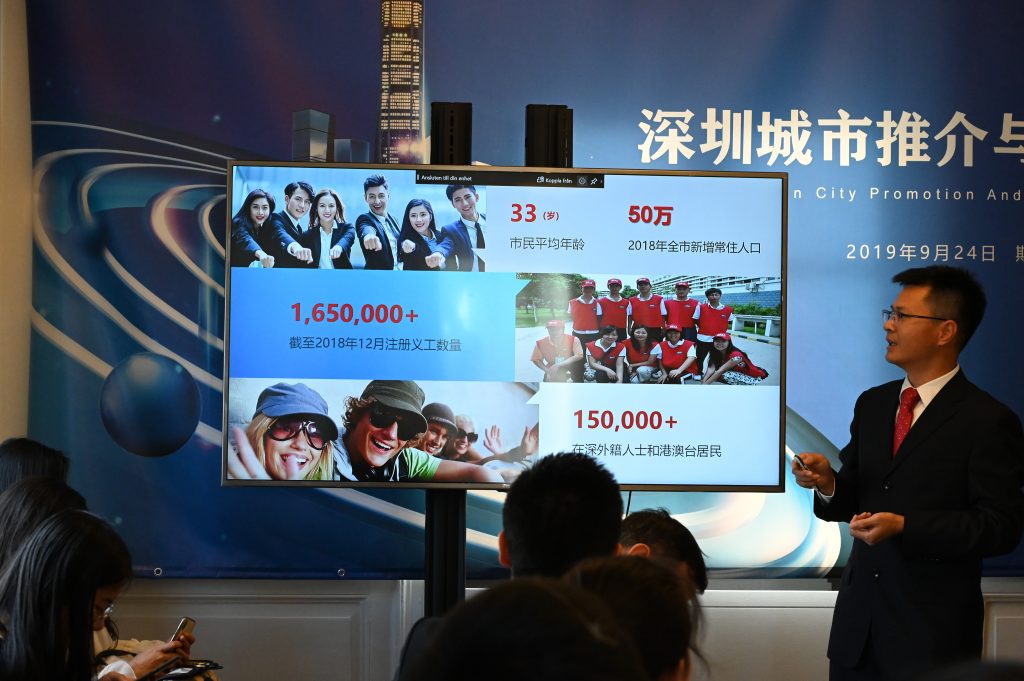Category Archives: Exchange
China and Sweden: Who Copies Who?
By Xuefei Chen Axelsson
Beijing, Oct. 14(Greenpost) – All advanced human civilization achievements can be learned and spread. When I was in Sweden, I went to Ikea to buy furniture. Then I saw the six small spoons which have different sizes. I was amazed and felt happy and surprised how Swedish people were so clever to give such a good measurement in the kitchen.

Then one day I went to the Far Eastern Museum in Stockholm, on the second floor they had a wonderful exhibition of Chinese antiques dating back to Xia and Shang Dynasty. The exhibition was well deployed with time schedule of Xia, Shang, Zhou, Qin, Han,,,Tang,Song, Yuan, Ming,Qing sequence. When you come to the Qin Dynasty,except Terra Cotta, you will see a bronze measurement instrument of six small spoons with different sizes. Oh, whose idea came first? Who copied who?
I was also surprised that in China we cannot see this and a lot of the antiques especially in the Xia and Shang dynasties, we can’t see them in China. We have forgotten our ancestors glorious culture and art. When we went to Great Britain Museum, American Museum, Museum in Switzerland and Gothenburg Museum, we saw a prosperous and rich China in many ways. The poverty in the 1950s, 60s and 70s has brainwashed the Chinese about what is a rich life. But people were more spiritual and people felt more equal because most of the people were poor.
When China became opening up, a lot of people went abroad, especially the elite Chinese went abroad despite of all kinds of difficulties because the gap between the west and China was too big.
I have interviewed a famous singer who said he could earn 1000 dollars by washing dishes a month with spare time while in China the formal permanent job would only earn him 20 dollars. With such a gap, people think there are gold in western countries. But now such gap has substantially narrowed down.
Judging from those second hand apartment, you can see how rich some newly-riched Chinese have become. 20 year old 150 or 174 square meters apartment, they don’t want it any more. They want to have new apartments. They want to have lift and live in a cleaner area with better environment and better maintainence in the area where it is almost like a garden.
Meanwhile, the old town is still the same as 20 years ago, not much change.
The young generation enjoy the more resources, but less time for eating and sleeping. Sometimes it can be too much food, sometimes it can be just western fast food. In the past, most Chinese were slim and even in their body. Nowadays we also have a lot of overweight, obesity children. Distorted resting time cause various health problems. The young generation has more eye-sight and teeth problems. Thus to plant tooth is a very popular business now.
While western countries see China as a “threat“, I just wonder how China can threat the west. Isn’t it you who made a Frankistan Giant? Or is it you dislike another country which is more like you? How have you threaten China with your culture? How much Chinese culture has been wiped out? When thinking of these questions we have to think that the global village made us interdependent and influence each other so much. Some people are nolstalgic and didn’t want to accept this globalization trend they started themselves. Sorry the trend is difficult to stop once the global machine or mechanism started.
Since China has learned from the western countries, in fact, both good and bad are included. Many problems western countries have experienced China is experiencing. One obvious problem is the substantial reduction of the population. Many schools in the countryside have to be closed and many hospitals have been replaced by barefoot kind of doctors and drug stores.

Urbanization is still going on in China. Young people move to the city while their parents still live in the countryside where there are only elderly people. While big cities absorbed all the migrant workers, their parents remain to live in small cities. Thus it is easier to see more older people in third level cities such as my hometown Jinzhou. Why are you afraid of China and think China as a threat? Ten years ago when I accompanied a delegation from South China to visit elderly home and small businesses, the leader with the delegation said thanks for your invitation because Today’s Sweden will be tomorrow’s China. In other words, today’s China is western countries yesterday. People are getting old. Senior citizen accounts for more than 20 percent of the population while the younger generation didn’t want to work as hard as the older generation. They relied on their parents more. Why do we have such a trend? Industrialization trend. When all the infrastructure has been improved, other development potential needs to be tapped. What is the future? Mankind must find a better way to go on. Do not live in a bad cycle of dynasties.
Swedish Influence in China
By Xuefei Chen Axelsson
Beijing, Oct.14(Greenpost)—When I was in Sweden, I always missed home China and tried to find Chinese footprint in Sweden, for example, the Chinese Palace in Drottningholm or the Gothenburg Boat in Gothenburg and if you visit the Gothenburg Museum, you even can see the trading paintings in the Qing Dynasty, marking the long history of trade between Sweden and China.
Now I am in China and I begin to think of Sweden and like to see the Swedish footprint in China. While in Beijing, you can’t help thinking of Sanlitun, a must-visit place for foreigners in Beijing. But now it has changed a lot. It is more modern with the constructions and buildings, but fewer people. Taiguli seemed to be a landmark building while Swedish brand H.M is just beside it not far away. I remember I also saw H.M in Xinjiang and Arla production line was there too. China now also has thousands of thousands of people who have problems that they could not eat flour and they have to eat the Chiazi or Linfro which reminds me of my daughter’s breakfast habit to have a smoothie with all kinds of seeds in it.
Oh, we not only live similar, but also sick similar! Thousands of thousands of people, especially young people take it as a hobby to have some starbucks or other coffee. When I was wandering in the new districts in Wanda Square, a famous brand in China, I saw starbucks and many other foreign names, operating prosperously there in Jinzhou city. In China if you buy clothes, you seldom find Chinese names, almost all the clothes have a foreign name, true or not, it sounds very foreign.
Volvo cars, Mercedes Benz, BMW, Honda, Toyota, Volksvagen, you name it, almost all the foreign brands are in China and new cars are full of streets and roads. Electric motorcycle replaced precious brandname of the kingdom of bikes except in Beijing and Hainan you still can use your mobilephone to scan the code and got a bike to ride. Private bikes have almost disappeared.
From outside, you even see a lot of western style buildings which are newly built. In Chaoyang District in Beijing, you have many buildings which looked like Gothe style, Holland village, Nordic Towns, Greenvillage, Hammarbysjostad-inspired Xiong’an and Zhangjiakou, Caofeidian are everywhere. Nowadays even the European especially the Nordic simple style has swept in the newly bought apartments in domestic decoration. I saw many kitchens almost the same as my own kitchen in Stockholm. The only difference in Jinzhou is that all the cooking device have been moved to the balcony and all the food should be cooked in balcony. Who comes out with this idea? But the other arrangements are very similar to the western style, Danmark or Sweden? Mine was Danmark.
Even the street art also reflects the similarity in our thinking. I don’t say that there are two Swedish art work in Yuquan Park in Western Beijing, even in Shuangjing area in eastern Beijing, I see a street art that was made on the wall similar to that street band in Malmo in Sweden. The figures even wear blue and yellow clothes with instruments in their hands. This is how Chinese think of Sweden I guess.
This also reminded me of the Chinese Palace in Drottningholm. Inside that building you see all the art decoration seem to be Chinese, you have ancient poet standing on a boat in a river and some characters look like Chinese but you can’t read it out at all. This symbolized how ancient Swedish artists or builders thought of China.
True we are in different world, we are different countries, but if you think Ericssion has come to Shanghai more than 100 years ago, Swedish prince was in Nanjing in 1926 and bought a lot of Chinese antiques later donated to Far East Asian Museum in Stockholm, a solid evidence of the exchange between Sweden and China.
Sometimes I visit you more often and you visit me less, sometimes you visit me less and I visit you more. Sometimes maybe this generation visited you more and next generation visited less. History showed that the exchange was not well balanced, but in general even with a gap of time and space, I can see the fact that we can’t stop exchange and mutual visits.
What I mentioned today is just a small sign of mutual exchange and cooperation, if you read the Chinese Ambassador Cui Aimin’s article in his embassy website, you will know even more detailed deepened cooperation between the two sides. (More stories to be continued)
China and Sweden who copies who?
By Xuefei Chen Axelsson
Beijing, Oct. 14(Greenpost) – All advanced human civilization achievements can be learned and spread. When I was in Sweden, I went to Ikea to buy furniture. Then I saw the six small spoons which have different sizes. I was amazed and felt happy and surprised how Swedish people were so clever to give such a good measurement in the kitchen.
Then one day I went to the Far Eastern Museum in Stockholm, on the second floor they had a wonderful exhibition of Chinese antiques dating back to Xia and Shang Dynasty. The exhibition was well deployed with time schedule of Xia, Shang, Zhou, Qin, Han,,,Tang,Song, Yuan, Ming,Qing sequence. When you come to the Qin Dynasty,except Terra Cotta, you will see a bronze measurement instrument of six small spoons with different sizes. Oh, whose idea came first? Who copied who?
I was also surprised that in China we cannot see this and a lot of the antiques especially in the Xia and Shang dynasties, we can’t see them in China. We have forgotten our ancestors glorious culture and art. When we went to Great Britain Museum, American Museum, Museum in Switzerland and Gothenburg Museum, we saw a prosperous and rich China in many ways. The poverty in the 1950s, 60s and 70s has brainwashed the Chinese about what is a rich life. But people were more spiritual and people felt more equal because most of the people were poor.
When China became opening up, a lot of people went abroad, especially the elite Chinese went abroad despite of all kinds of difficulties because the gap between the west and China was too big.
I have interviewed a famous singer who said he could earn 1000 dollars by washing dishes a month with spare time while in China the formal permanent job would only earn him 20 dollars. With such a gap, people think there are gold in western countries. But now such gap has substantially narrowed down.
Judging from those second hand apartment, you can see how rich some newly-riched Chinese have become. 20 year old 150 or 174 square meters apartment, they don’t want it any more. They want to have new apartments. They want to have lift and live in a cleaner area with better environment and better maintainence in the area where it is almost like a garden.
Meanwhile, the old town is still the same as 20 years ago, not much change.
The young generation enjoy the more resources, but less time for eating and sleeping. Sometimes it can be too much food, sometimes it can be just western fast food. In the past, most Chinese were slim and even in their body. Nowadays we also have a lot of overweight, obesity children. Distorted resting time cause various health problems. The young generation has more eye-sight and teeth problems. Thus to plant tooth is a very popular business now.
While western countries see China as a “threat“, I just wonder how China can threat the west. Isn’t it you who made a Frankistan Giant? Or is it you dislike another country which is more like you? How have you threaten China with your culture? How much Chinese culture has been wiped out? When thinking of these questions we have to think that the global village made us interdependent and influence each other so much. Some people are nolstalgic and didn’t want to accept this globalization trend they started themselves. Sorry the trend is difficult to stop once the global machine or mechanism started.
Since China has learned from the western countries, in fact, both good and bad are included. Many problems western countries have experienced China is experiencing. One obvious problem is the substantial reduction of the population. Many schools in the countryside have to be closed and many hospitals have been replaced by barefoot kind of doctors and drug stores.
Urbanization is still going on in China. Young people move to the city while their parents still live in the countryside where there are only elderly people. While big cities absorbed all the migrant workers, their parents remain to live in small cities. Thus it is easier to see more older people in third level cities such as my hometown Jinzhou.
Why are you afraid of China and think China as a threat? Ten years ago when I accompanied a delegation from South China to visit elderly home and small businesses, the leader with the delegation said thanks for your invitation because Today’s Sweden will be tomorrow’s China. In other words, today’s China is western countries yesterday. People are getting old. Senior citizen accounts for more than 20 percent of the population while the younger generation didn’t want to work as hard as the older generation. They relied on their parents more. Why do we have such a trend? Industrialization trend. When all the infrastructure has been improved, other development potential needs to be tapped. What is the future? Mankind must find a better way to go on. Do not live in a bad cycle of dynasties.
Is United Front a “threat”?
By Xuefei Chen Axelsson
Beijing, Oct. 14 (Greenpost) – On Oct.1, TV 4 in Sweden published a news about China in KALLA FAKTA which seemed to have found a big secret about China. That is the United Front Work Department and its relations with overseas Chinese.
Last night I couldn’t sleep, I began to read in English about what is United Front. The study about United Front started in Canterbury University in New Zealand in 2017 and then Australian thinktank continued to publish articles and papers to explain the United Front’s role in the Communist Party of China.
When I read TV4 article, I see the language is like this, whenever they mentioned China, they will mention like China dictatorship as Chinese authorities. I just wonder if China is a dictatorship, why do they have other eight parties and many social organizations and people’s communities, trade union and workers federations and friendship federations for overseas Chinese and many others?
In the articles, it explained that United Fronts is an organization to make friends with overseas Chinese and many others. In other words, I think it shows the Communist Party is not a dictatorship, but rather democratic because they would absorb all the people’s opinions and suggestions for the benefit of all the people in society in their ruling.
It sounds like a secret for many westerners because they have never seriously studied about Communist Party of China. They thought it was the same as the former Soviet or other socialist country. But the fact is CPC is really special. It is the world’s largest party which has nearly 100 million members. Almost among every 13 people, there is one party member. And this party member must abide by the party’s charter and really serve the people. He or she must be very healthy, capable in leading the people for a better life. CPC is a ruling party, but it must serve the people. For example, to get rid of extreme poverty. Now with the overwhelming amount of real estate, you can see it is easy to meet people’s demand. China is not a shortage economy any more. The supply is larger than the demand. The main problem is how to distribute the wealth.
China is dealing with this problem now. For example, if a person got cancer, he or she would have minimium cost in treatment at hospital. This is a good welfare system.
Elderly care is very well in cities. For example the senior citizen who is above 60, there will be no need to pay bus or park fees. It is free for them.
Chinese culture is to pay attention to family relations. And this family can be inside China and can be international. China likes to keep good relations with overseas Chinese. This was a great improvement in China. During the 1960 and 1970s even 1980s, we dare not say that we have overseas relatives. Why? Because then the overseas relative would be treated as a traitor or enemy. But now people feel proud to have an overseas relative because we think western countries living standards are quite high and advanced. We have to learn from them.
About 10 years ago, Sweden was also open to teach the Chinese how to live a better life. The visitors not necessarily bought a lot of gifts but learn more ideas and implemented in reality. Now I find that many ideas were really realized in reality. A lot of new parks and lakes with clean water and green grass have been built. The environment has substantially improved. Now we begin to appreciate the blue sky when we took it for granted in the 1980s and even before that time. It is true that United Front means to unite all the friends and try to make friends with all the people who love peace and development. But what is wrong with it? Even God said those who have self-discipline will have no problem. Learning from each other and make common progress is not a problem.
Reformer, öppnande och tolerans främjar en framgångsrik utveckling i Kina
Stockholm, Okt.10(Greenpost) — Reformer, öppnande och tolerans främjar en framgångsrik utveckling i Kina är en signerad artikel av Ambassadör Gui Congyou för svenska medier. Hela texter är som nedande:
Den 1 oktober 1949 grundades Folkrepubliken Kina. Detta avslutade Kinas nedsatte årshundrad som präglades av invaderingar och plundringar av västmakterna. Förtrycket av ”de tre bergen”- imperialism, feodalism och byråkratisk kapitalism störtades och det kinesiska folket har sedan stått upp och blivit herrar i sitt eget land, medan landets utveckling rusat intill en helt ny era.
Under de 71 åren sedan Nya Kina grundades, och särskilt under de senaste 40 åren av reformer och öppningar mot omvärlden, har Kina uppnått en framåtklivande snabb utveckling.
Dagens Kina har det bästa mänskliga rättigheter i sin historia. Under mer än 5000 år har det varit drömmar från generationer av kineser att skapa ett välmående samhälle utan bekymmer om mat och kläder och att grunda ett samhälle av ”stor harmoni” där allas rättigheter och värdighet respekteras och skyddas fullt ut. Nya Kina förvandlade denna dröm till verklighet. Om 3 månader är det tiden vi bygger färdigt det ”välmående samhälle” där absolut fattigdom utrotas i Kina där en femtedel av världens befolkning inte längre oroas över svält eller köld. Vi har redan rest upp världens största och mest omfattande socialförsäkrings-, sjukförsäkrings- och obligatoriska utbildningssystem. Folkets rättigheter att delta i statlig och social styrning är fullt garanterade. Nya Kina har lagstadgat jämställdhet mellan kvinnor och män i konstitutionen, och arbetat målmedvetet med jämställdhet, och aktivt stärkt kvinnors rättigheter. För närvarande är andelen kvinnliga sysselsatta i hela samhället 43,7%. Vi följer jämlikheten mellan alla etniska grupper och genomför politik för etnisk regional autonomi. Etniska minoriteters rättigheter att få utbildning, använda och utveckla sitt talade och skrivna språk samt upprätthålla sina egna kulturella traditioner och religiösa övertygelser respekteras och garanteras. 53 av de 55 etniska minoriteterna talar egna språk. I Xizang (eller Tibet som svenskar brukade skriva) finns det mer än 1700 platser för tibetansk buddhismaktivitet, med mer än 46 000 munkar och nunnor som bor i tempel och kloster. I Xinjiang finns det mer än 24 000 moskéer, och i genomsnitt äger 530 muslimer en moské, vilket är utstående även bland muslimska länder.
Att skapa en ekologisk civilisation har blivit en grundläggande nationell politik för Kinas utveckling. Idag har andelen kol av Kinas totala energiförbrukning minskat från cirka 70% till 59%, och andelen lågutsläpp uppgraderade termisk krafter har nått mer än 80%. Under de senaste 20 åren utgörs ca 25% av hela världens nya växtlighetstäckta yta av Kina, som är största på Jorden. Kina utvecklar kraftigt gröna transporter. Produktions- och försäljningsvolymen för el- och hybrid-bilar har rankats som först i världen i många år, med en kumulativ summa av 1,8 miljoner fordon, och står för mer än 50% av världens bilar av denna typ. Ett snabbtågjärnvägsnät som täcker hela landet är en grundbult. Delade cyklar är populära över hela landet. Som det största utvecklingslandet har Kina implementerat en nationell strategi för att aktivt reagera på världens klimatförändringar, slutfört klimatåtgärdens mål 2020 före schemat och gjort stora bidrag till det globala svaret på klimatfrågor.
När det gäller kampen mot Covid-19 är Kina en aktiv deltagare och en viktig bidragsgivare till det globala samarbetet. Inför det plötsliga utbrottet av Covid-19 i början av detta år insisterade det kinesiska partiet och regeringen på att folks liv är högsta prioritet och startade snabbt ett totalt folkkrig för förebyggande och kontroll av epidemien. Landets 1.4 miljarder människor har jobbat stenhårt tillsammans för att inledningsvis begränsa epidemins spridning på ungefär en månad, pressa de inhemska dagliga nya fallen ner till under 10 per dag inom två månader och få avgörande vinst i Wuhan och Hubei provins på tre månader, därpå kunde man få det strategiskt viktiga resultat i den nationella kampen.
Samtidigt fullgör Kina aktivt sina internationella ansvar. Vi rapporterar proaktivt epidemi-informationen till Världshälsoorganisationen och relevanta länder och regionala organisationer släpper den nya koronavirusgensekvens och släpper diagnos och behandlingsplan samt plan för förebyggande och kontroll allt vid det tidigaste möjliga tillfället, bara för att dela värdefulla information om förebyggande, kontroll och behandlingserfarenhet med omvärlden. Kina förespråkar aktivt upprättandet av ett globalt samhälle för människors hälsa, skickade expertgrupper till 32 länder, tillhandahöll 283 gånger hjälpmaterial till 150 länder och fyra internationella organisationer och intensifierade exporten av stora mängder anti-epidemiskt material.
Som världens största leverantör av anti-epidemiförbrukning hade Kina i början av september exporterat 151,5 miljarder masker, 1,4 miljarder skyddskläder, 230 miljoner skyddsglasögon och 470 miljoner testpaket. Kina kommer också att fortsätta att främja en rad internationella samarbetsåtgärder för förebyggande och kontroll av epidemier, inklusive att göra vacciner till en global offentlig produkt efter det att de nya Corona-vaccinen är färdiga att tas i bruk.
Kina har alltid varit en bidragsgivare till världsutvecklingen, en byggare av världsfred och en försvarare av internationell ordning. Kina har blivit den största handelspartnern till mer än 130 länder och regioner i världen och den viktigaste marknaden för stora multinationella företag. Kinas totala tullnivå har sjunkit under 7,5%, vilket är nära den europeiska nivån, och planeras att fortsätta sänkas i framtiden. Tillgången till den kinesiska marknaden expanderar också och den har blivit en av de ekonomier som har haft den största förbättringen av affärsmiljön under de senaste två åren. Samtidigt har Kina alltid bedrivit en defensiv försvarspolitik, som åtagit sig att skydda sin egen suveränitet, självständighet och territoriella integritet, och kommer aldrig att skada utan stödja andra länders ansträngningar för att skydda suveränitet, självständighet och territoriell integritet och motsätter sig resolut aggression och krig. Kina vill skydda det internationella systemet med FN som kärnan och den internationella ordningen baserad på folkrätt.
I början kopierades Nya Kina Sovjetunionens centraliserade statliga styrningssystem i sin helhet, särskilt det planerade ekonomiska systemet, vilket allvarligt hindrade Kinasutveckling av produktivitet och folks strävan efter ett bättre liv, som följd fastnade landets utveckling på länge. År 1978 började Kina grundligt reformera detta styva ledningssystem. Man utvecklade kraftigt demokrati i statlig förvaltning och införde marknadskonkurrens inom ekonomisk utveckling, vilket kraftigt stimulerade folks initiativ, entusiasm och kreativitet för att bygga landet och skapa ett bättre liv. Motorn för social och ekonomisk utveckling aktiverades. Kina kommer att fortsätta att reformera produktionsförhållanden och låta marknaden spela en avgörande roll i fördelningen av resurser.
Medan Kina fortsätter att fördjupa interna reformer, främjar Kina kraftigt öppnandet för omvärlden och introducerar avancerade utländska förvaltningskoncept, erfarenhet, kapital och teknik för att hjälpa den inhemska utvecklingen.
När Kina var självbelåten, stängde landet mot omvärlden, och vägrade at acceptera avancerade utvecklingskoncept, erfarenheter och prestationer, kom Kina på efterkälken. Öppenhet eller slutenhet avgör Kinas framtid och öde. Även om Kina har blivit världens näst största ekonomi, kommer takten i öppnandet mot omvärlden inte att minska. Kina ska öppnas mer och mer. För närvarande har utländska försäkringsbolag och avancerade biltillverkare möjlighet att etablera helägda företag i Kina eller kontrollera mer aktie andel även aktiemajoritet i kinesisk-utländska joint venture.
En annan viktig aspekt av Kinas framgångsrika utveckling är Tolerans. Det finns mer än 190 länder och tusentals etniska grupper i världen, med olika civilisationer. Varje land, nation och civilisation har sina egna egenskaper och fördelar. Tolerans, ömsesidigt utbyte och lärande från varandra gäller inte bara för varje land, utan också för harmoni i världen och att undvika hat, konflikt och krig. Filosofisk sett finns det inte två identiska löv i världen. Kineser säger att havet tar emot varje ström för att vara stort. Om du inte kan tolerera andra, kan du inte få det du förtjänar för att överleva och utvecklas. Kinas system har utvecklats ur sin egen historia, egenskaper och nationella förhållanden och stöds av det kinesiska folket. Men det är inte nödvändigtvis lämpligt för andra länder. Vi strävar inte efter att införa vårt system i andra länder och vi accepterar inte att andra länder tvinga sina egna system på Kina. Kina försöker inte använda sitt eget system för att transformera andra länder och vägrar andra länder att använda sin makt att omvandla Kina. Vi står för ömsesidig respekt, likabehandling och icke-inblandning i varandras interna angelägenheter med alla länder i världen. Samtidigt betonar vi dialog, kommunikation, utbyte, ömsesidigt lärande, gemensam utveckling och gemensamma framsteg.
(Xuefei Chen Axelsson)
改革、开放、包容促进中国成功发展
(桂从友大使发瑞典媒体署名文章)
1949年10月1日,中华人民共和国成立,结束了近代100余年来受西方列强侵占、掠夺的屈辱史,推翻帝国主义、封建主义、官僚资本主义三座大山的压迫,中国人民从此站起来了,成了自己国家的主人,中国的发展翻开了全新的一页。
新中国成立71年来,特别是改革开放40多年来,中国实现了跨越式发展。
当今中国的人权状况处于历史最好时期。在中国5000多年的历史进程中,实现衣食无忧的小康,创建人的各项权利和尊严得到充分尊重和保护的“大同”社会一直是一代代中国人孜孜以求的梦想。新中国将这一梦想变为现实。再过3个月,我们将全面建成小康社会,彻底消灭绝对贫困,让占全球五分之一的人口不愁吃、不愁穿。我们建成了世界规模最大、覆盖人数最多的社会保障、医保和义务教育体系。人民参加国家和社会治理的各项权利得到充分保障。新中国将男女平等写入宪法,大力推进性别平等工作,积极促进妇女权益。目前全国女性就业人员占全社会就业人员的比重为43.7%。我们坚持各民族一律平等,实行民族区域自治政策,少数民族接受教育、使用发展本民族语言文字以及保持自身文化传统、宗教信仰等各项权利得到切实尊重和保障。55个少数民族中53个都有本民族语言。中国西藏有藏传佛教活动场所1700多处,住寺僧尼4.6万多人。新疆的清真寺有2.4万多所,平均每530名穆斯林民众就拥有一座清真寺,这一比例超过许多穆斯林国家。
生态文明建设成为中国发展的一项基本国策。在当今中国的能源消费中,煤炭的占比从以前的70%左右降到59%,火电超低排放改造比例达到80%以上。近20年来中国新增植被覆盖面积约占全球新增总量的25%,居全球首位。中国大力发展绿色交通,新能源汽车产销量连续多年世界第一,累计保有量达180万辆,占全球50%以上。覆盖全国的高铁网基本形成,共享单车等绿色出行方式风靡全国。作为最大的发展中国家,中国实施积极应对气候变化国家战略,提前完成2020年气候行动目标,为全球应对气候变化作出重大贡献。
中国是全球合作抗疫的积极参与者和重要贡献者。面对今年初突如其来的新冠肺炎疫情,中国党和政府坚持人民至上、生命至上,迅速打响疫情防控的人民战争、总体战、阻击战。14亿人民克服困难,付出巨大努力,用1个多月的时间初步遏制疫情蔓延势头,用2个月时间将本土每日新增病例控制在个位数以内,用3个月时间取得武汉和湖北保卫战的决定性成果,进而取得全国抗疫斗争重大战略成果。与此同时,中国积极履行国际责任,第一时间向世界卫生组织、有关国家和地区组织主动通报疫情信息,第一时间发布新冠病毒基因序列信息,第一时间公布诊疗方案和防控方案,毫无保留地分享防控和救治经验。中国积极倡导构建人类卫生健康共同体,向32个国家派出专家组,向150个国家和4个国际组织提供283批抗疫援助,并加紧出口大量抗疫物资。作为全球抗疫物资最大供应国,至9月初,中国已对外出口口罩1515亿只、防护服14亿件、护目镜2.3亿个、检测试剂盒4.7亿人份。中国还将继续推进疫情防控国际合作一系列举措,包括在新冠疫苗研发完成并投入使用后将疫苗作为全球公共产品。
中国始终是世界发展的贡献者、世界和平的建设者、国际秩序的捍卫者。中国已成为全球130多个国家和地区的最大贸易伙伴,是各大跨国企业最重要的市场。中国总体关税水平已降至7.5%以下,已接近欧洲水平,而且未来还将继续下降。中国市场准入也在不断扩大,已连续两年成为营商环境改善幅度最大的经济体之一。与此同时,中国始终奉行防御性的国防政策,致力于维护自身主权、独立和领土完整,决不损害、而是坚定支持世界各国维护主权、独立、领土完整的努力,坚决反对侵略和战争,坚定维护以联合国为核心的国际体系和以国际法为基础的国际秩序。
新中国成立初期,全盘照搬苏联高度集中的国家管理体制尤其是计划经济体制,严重阻碍社会生产力的发展和人民对美好生活的追求,导致国家发展长期贫穷落后。1978年,中国开始深刻改革这种僵化的管理体制,在国家管理中大力发展民主,在经济发展中引入市场竞争,极大地激发了人民建设国家和创造美好生活的主动性、积极性和创造性,激活了社会经济发展的引擎。中国将始终致力于改革一切不适应生产力发展的生产关系,使市场在资源配置中发挥决定性作用,将改革进行到底。
中国在不断深化内部改革的同时,大力推进对外开放,引进国外先进的管理理念、经验及资金、技术,助力国内发展。近代中国故步自封、闭关锁国,拒绝接纳外部先进发展理念、经验和文明发展成果,导致落后挨打。开放与封闭,决定着中国的前途和命运。尽管中国已成为世界第二大经济体,但开放的脚步不会停,而且开放的大门会越开越大。现在,已有国外保险公司、先进汽车制造企业等在中国建独资企业,或更多参股乃至可以控股中外合资企业。
包容是中国成功发展的另一条重要经验。世界上有190多个国家,上千个民族,有着各种文明,每个国家、民族、文明都有自己的特点和优势,彼此包容、相互交流、互学互鉴既是每个国家、民族和文明生存、发展之道,也是世界避免仇视、冲突和战争的和谐之道。从哲学上讲,世界上没有两片完全相同的树叶。中国人讲,海纳百川,有容乃大。不能包容别人,自己也得不到应有的生存和发展之道。中国的制度适合自己的历史、特点和国情,为中国人民所拥护,但不一定适合他国。我们不谋求将自己的制度强加于他国,也不接受他国将自己的制度强加给中国。中国不谋求用自己的制度改造他国,也拒绝他国用自己的制度改造中国。我们主张同世界各国相互尊重、平等相待、互不干涉内政,同时加强对话、沟通、交流,互学互鉴,共同发展,共同进步。
Nobel Media interviews Nobel laureate in Medicine Rice over the phone
Editor Xuefei Chen Axelsson
Ambassador Gui: Reformer, öppnande och tolerans mot omvärlden främjar en framgångsrik utveckling i Kina
Stockholm, Sept. 28 (Greenpost) — Den 27 september höll Kinesiska ambassaden Kinesiska Nationella Dag firande på webben. Kinesiska ambassadör Gui Congyou berättade för kinesiska representativ om kinas utveckling läget och varför kina kan utveckla så snabbt.
Han sa at den 1 oktober 1949 grundades Folkrepubliken Kina och det kinesiska folket har sedan stått upp och blivit herrar i sitt eget land, och Kina har utvecklats i en ny riktning. Detta avslutade gamla kinas historien som invaderas och plundras av västmakter i mer än 100 år i modern tid och störtade förtrycket av ”de tre bergen” av imperialism, feodalism och byråkratisk kapitalism.
Under de 71 åren sedan Nya Kina grundades, och särskilt under de senaste 40 åren av reformer och öppningar mot omvärlden, har Kina uppnått en snabb ekonomiska utveckling och utveckling på olika perspektiv.
Mänskliga Rättigheter
Mänskliga rättigheter har utvecklats mycket i Kina under den här perioden och det kunde vara bästa tiden om det bedömas utifrån Kinas långa historia. Under mer än 5000 år har det varit drömmar från generationer av kineser att förverkliga ett välmående samhälle utan bekymmer om mat och kläder och att skapa ett ”gemmansam” samhälle där grundarnas rättigheter och värdighet respekteras och skyddas fullt ut. Nya Kina förvandlade denna dröm till verklighet. I slutet av året ska vi helt utrota absolut fattigdom i Kina. Vi kommer då ha världens största socialförsäkrings-, sjukförsäkrings- och obligatoriska utbildningssystem. Folkets rättigheter att delta i statlig och social styrning är fullt garanterade. Nya Kina har lagstadgat jämställdhet mellan kvinnor och män i konstitutionen, och arbetat målmedvetet med jämställdhet, och aktivt stärkt kvinnors rättigheter. För närvarande är andelen kvinnliga sysselsatta i hela samhället 43,7%. Vi följer jämlikheten mellan alla etniska grupper och genomför politik för etnisk regional autonomi. Etniska minoriteters rättigheter att få utbildning, använda och utveckla sitt modersmål och både talade och skrivna språk samt upprätthålla sina egna kulturella traditioner och religiösa övertygelser respekteras och garanteras. I 53 av de 55 etniska minoriteterna dominerar egna språk. Det finns mer än 1700 platser för tibetansk buddhismaktivitet i Tibet Autonoma Regionen, med mer än 46 000 munkar och nunnor som bor i kloster. Det finns mer än 24 000 moskéer i Xinjiang Uyghur Autonoma Regionen, och i genomsnitt äger 530 muslimer en moské, vilket är mer än många muslimska länder.
Ekologisk civilisation och Klimatförändringar
Tanken att skapa en ekologisk civilisationen har blivit en grundläggande nationell politik för Kinas utveckling. Idag har andelen kol av Kinas totala energiförbrukning minskat från cirka 70% till 59%, och andelen ultra-låg utsläpp av termisk kraft nått mer än 80%. Under de senaste 20 åren har Kina ökat andelen av gräs, skog och jordbruksmark, som tidigare var öken. Liknande arbete görs runt om i världen och Kinas andel är 25 % av denna nya ”gröna” mark och Kina är ledande i denna verksamhet.
Kina utvecklar kraftigt gröna transporter. Produktions- och försäljningsvolymen för el- och hybrid-bilar har rankats som först i världen i många år, med en kumulativ summa av 1,8 miljoner fordon, och står för mer än 50% av världens bilar av denna typ. Ett snabbtågjärnvägsnät som täcker hela landet är en grundbult. Delade cyklar är populära över hela landet och är en annan viktig aspekt. Som det största utvecklingslandet har Kina implementerat en nationell strategi för att aktivt reagera på världens klimatförändringar, slutfört klimatåtgärdens mål 2020 före schemat och gjort stora bidrag till det globala svaret på världens klimatförändringar.
Kampen mot Covid 19 epidemin
Kina är en aktiv deltagare och en viktig bidragsgivare till det globala samarbetet i kampen mot epidemin. Inför det plötsliga utbrottet av Covid 19 i början av detta år insisterade det kinesiska partiet och regeringen på att folks liv är högsta prioritet och startade snabbt folkets aktion för förebyggande och kontroll av epidemien och med tanke även på framtida epidemier.
Landets 1.4 miljarder människor har jobbat tillsammans för att inledningsvis begränsa epidemins spridning på ungefär en månad, kontrollera de dagliga nya fallen i lokalområdet på två månader och få ner spridningen radikalt, och få avgörande resultatet i Wuhan och Hubei provins om tre månader. Det var bra för den nationella kampen mot epidemin i Kina.
Samtidigt fullgör Kina aktivt sina internationella ansvar, rapporterar proaktivt epidemi-informationen till Världshälsoorganisationen och relevanta länder och regionala organisationer så snart som möjligt, släpper den nya koronavirusgensekvens så snart som möjligt och släpper diagnos och behandlingsplan samt plan för förebyggande och kontroll så snart som möjligt.
Kina delade information om förebyggande, kontroll och behandlingserfarenhet med omvärlden. Kina förespråkar aktivt upprättandet av ett samhälle för människors hälsa, skickade expertgrupper till 32 länder, tillhandahöll 283 gånger anti-epidemihjälp material till 150 länder och fyra internationella organisationer och intensifierade exporten av stora mängder anti-epidemiskt material.
Som världens största leverantör av anti-epidemiförbrukning hade Kina i början av september exporterat 151,5 miljarder masker, 1,4 miljarder skyddskläder, 230 miljoner skyddsglasögon och 470 miljoner testpaket. Kina kommer också att fortsätta att främja en rad internationella samarbetsåtgärder för förebyggande och kontroll av epidemier, inklusive att göra vacciner till en global offentlig produkt efter det att de nya corona-vaccinen är färdiga att tas i bruk.
Fred, Handel och FN
Kina har alltid varit en bidragsgivare till världsutvecklingen, en byggare av världsfred och en försvarare av internationell ordning. Kina har blivit den största handelspartnern i mer än 130 länder och regioner i världen och den viktigaste marknaden för stora multinationella företag. Kinas totala tullnivå har sjunkit under 7,5%, vilket är nära den europeiska nivån, och planeras att fortsätta sänkas i framtiden. Tillgången till den kinesiska marknaden expanderar också och den har blivit en av de ekonomier som har haft den största förbättringen av affärsmiljön under de senaste två åren. Samtidigt har Kina alltid bedrivit en defensiv nationell försvarspolitik, som åtagit sig att skydda sin egen suveränitet, självständighet och territoriella integritet, och kommer aldrig att skada utan stödja länders ansträngningar för att skydda suveränitet, självständighet och territoriell integritet och motsätter sig resolut aggression och krig.
Kina vill skydda det internationella systemet med FN som kärnan och den internationella ordningen baserad på internationella lag.
Reformer och öppnande mot omvärlden
I början kopierades Nya Kina Sovjetunionens centraliserade statliga ledningssystem och gjorde det planerade ekonomiska systemet, i sin helhet, vilket allvarligt hindrade utvecklingen av social produktivitet och folks strävan efter ett bättre liv för att det inte kunde uppmuntra individens entusiasm för jobb.
År 1978 började Kina grundligt reformera detta styva ledningssystem och gav mer kraft och frihet till folk i landet. Kina utvecklade kraftigt demokrati och medbestämmande i statlig förvaltning och införde marknadskonkurrens inom ekonomisk utveckling, vilket kraftigt stimulerade folks initiativ, entusiasm och kreativitet för att bygga landet och skapa ett bättre liv. Motorn för social och ekonomisk utveckling aktiverades. Kina kommer att fortsätta att reformera produktionsförhållanden och låta marknaden spela en avgörande roll i fördelningen av resurser.
Medan Kina fortsätter att fördjupa interna reformer, främjar Kina kraftigt öppnandet för omvärlden och introducerar avancerade utländska förvaltningskoncept, erfarenhet, kapital och teknik för att hjälpa den inhemska utvecklingen.
När Kina var självbelåten, stängde landet mot omvärlden, och vägrade at acceptera avancerade utvecklingskoncept, erfarenheter och prestationer, kom Kina på efterkälken. Öppenhet eller slutenhet avgör Kinas framtid och öde. Även om Kina har blivit världens näst största ekonomi, kommer takten i öppnandet mot omvärlden inte att minska. Kina ska öppnas mer och mer. För närvarande har utländska försäkringsbolag och avancerade biltillverkare etablerat helägda företag i Kina. Utländska ägare har möjlighet till kontroll över kinesisk-utländska joint venture genom aktie-majoritet.
Tolerans
Tolerans är an annan viktig aspekt av Kinas framgångsrika utveckling. Det finns mer än 190 länder och tusentals etniska grupper i världen, med olika civilisationer. Varje land, nation och civilisation har sina egna egenskaper och fördelar. Tolerans, ömsesidigt utbyte och lärande från varandra gäller inte bara för varje land, utan också för harmoni i världen och att undvika hat, konflikt och krig. Filosofisk sett finns det inte två identiska löv i världen. Kineser säger att tolerans är centralt. Om du inte kan tolerera andra kan du inte få det du förtjänar för att överleva och utvecklas. Kinas system har utvecklats ur sin egen historia, egenskaper och nationella förhållanden och stöds av det kinesiska folket. Men det är inte nödvändigtvis lämpligt för andra länder. Vi strävar inte efter att införa vårt system i andra länder och vi accepterar inte att andra länder inför sina egna system i Kina. Kina försöker inte använda sitt eget system för att transformera andra länder och vägrar andra länder att använda sin makt att omvandla Kina. Vi står för ömsesidig respekt, likabehandling och icke-inblandning i varandras interna angelägenheter med alla länder i världen. Samtidigt betonar vi dialog, kommunikation, utbyte, ömsesidigt lärande, gemensam utveckling och gemensamma framsteg.
Finland’s Restrictions on entry into the country to be tightened due to COVID-19
Stockholm, 24 September, (Greenpost)– Today, the Finnish Government adopted a decision on restrictions on entry into the country, which will enter into force on 28 September. Restrictions on entry will be reintroduced for traffic between Finland and Estonia, Germany, Iceland, Norway, Slovakia and Sweden, as well as for residents of Canada, Georgia and Tunisia who are travelling from their home country to Finland. Restrictions will be lifted for traffic arriving in Finland from San Marino.
Day-to-day travel will still be permitted for local border communities at Finland’s land border with Sweden and Norway. In addition, from Monday 28 September, people will be able to come to work in Finland from Sweden and Estonia without a 14-day self-isolation period.
From now on, the list of restricted and permitted countries will be reviewed on a weekly basis and updated as necessary. Changes in entry restrictions will be made based on an expert assessment by the Finnish Institute for Health and Welfare (THL) using data from each Monday. The limit value of 25 new cases per 100,000 persons in the previous 14 days will apply to the EU and Schengen countries and the countries on the Green List defined by the Council of the European Union. Any changes will be decided on at the Thursday government session.
Restrictions on internal border traffic from 28 September
Internal border traffic refers to traffic between Finland and other Schengen countries. Starting from 28 September, entry into Finland from Cyprus, Latvia, Liechtenstein, Lithuania, Poland, San Marino and the Vatican will not be restricted.
As a result of the Government’s decision, restrictions on internal border traffic will be in force from 28 September for traffic between Finland and Austria, Belgium, the Czech Republic, Denmark, Estonia, France, Germany, Greece, Hungary, Iceland, Italy, Luxembourg, Malta, the Netherlands, Norway, Portugal, Slovakia, Slovenia, Spain, Sweden and Switzerland, apart from certain exceptions.
Day-to-day travel will still be permitted for local border communities at Finland’s land border with Sweden and Norway. In addition, from Monday 28 September, people will be able to come to work in Finland from Sweden and Estonia without a 14-day self-isolation period. Leisure boating from the EU and Schengen countries to Finland will not be restricted either.
At the internal borders, restrictions on entry allow only return traffic to Finland, transit traffic, work-related travel and travel for other essential reasons, apart from the above-mentioned exceptions. A 14-day period of self-isolation is recommended for travellers arriving in Finland. Starting from 1 October, travellers may, at their discretion, shorten their period of self-isolation by taking two voluntary COVID-19 tests.
Restrictions on external border traffic from 28 September
External border traffic refers to traffic between Finland and non-Schengen countries. Starting from 28 September, restrictions on external border traffic will be lifted for traffic arriving in Finland from Cyprus, San Marino and the Vatican, and for traffic between Finland and Australia, Japan, Rwanda, South Korea, Thailand, New Zealand and Uruguay for residents of these countries.
People may come to Finland from the following countries for work or another essential reason: Andorra, Bulgaria, Croatia, Ireland, Monaco, Romania and the United Kingdom. A 14-day period of self-isolation is recommended for travellers arriving in Finland.
For all other non-Schengen countries, restrictions on entry allow only return traffic to Finland and other EU and Schengen countries, transit traffic at Helsinki Airport and other essential traffic. In addition, a 14-day period of self-isolation is recommended for travellers arriving in Finland.
Starting from 1 October, travellers may, at their discretion, shorten their period of self-isolation by taking two voluntary COVID-19 tests.
New health security measures from 1 October
Finland will introduce new travel-related health security measures from 1 October. These are based on the Government’s resolution of 11 September. The aim is to ease the conditions for work-related travel in particular.
From 1 October, two voluntary COVID-19 tests will be recommended for travellers arriving in Finland from countries with a higher incidence and from which entry into Finland is restricted. An exception is that people from Sweden and Estonia may come to work in Finland without self-isolation or testing. Similarly, residents of border communities at the land borders between Finland and Sweden and between Finland and Norway will not need to self-isolate.
Voluntary COVID-19 tests will allow travellers to shorten the recommended 14-day period of self-isolation.
Residents of Finland returning from countries with higher incidence rates could, at their discretion, shorten the 14-day period of self-isolation by taking a test at the airport or port as soon as they arrive in Finland, followed by a second test in their home municipality after 72 hours at the earliest from taking the first test.
For other travellers arriving in Finland, the recommendation will be to take the first test up to 72 hours (3 days) before arrival. The second test should be taken no earlier than 72 hours (3 days) after entry into the country. Until receiving the result of the second test, persons entering the country should remain in self-isolation at their place of residence. The self-isolation period will end if the test result is negative. If the test result is positive, the doctor will place the person in quarantine until they have recovered.
Travellers staying in Finland for less than three days (less than 72 hours) will not be required to quarantine or take a second test.
Restrictions on entry and recreational travel
When entry into the country is restricted, recreational travel to Finland from the countries in question is no longer allowed. In this case, only return traffic to Finland, transit traffic, work-related travel or travel for other essential reasons are allowed. In addition, self-isolation and testing are recommended for travellers.
The lifting of entry restrictions means that recreational travel to Finland is permitted for people from these countries. In this case, travellers will not need to self-isolate upon their arrival in Finland or take a COVID-19 test.
Rights of Finnish citizens and residents of Finland
Under section 9 of the Constitution of Finland, Finnish citizens and residents of Finland always have the right to return to Finland, and everyone has the right to leave Finland if they so wish, provided that there is no legal impediment to this. However, the Government still recommends avoiding unnecessary travel to other countries, except for countries for which the restrictions on entry have been lifted.
Self-isolation
According to the guidelines of the Finnish Institute for Health and Welfare, it is not recommended to go to a workplace, day care centre or school during the period of self-isolation. Essential travel, such as a visit to a doctor, is allowed. In this case, it is recommended to wear a face covering or a face mask. Public transport should be avoided. Travellers arriving in the country will be given instructions on how to proceed.
Travellers must be aware of the current entry and quarantine regulations of their country of destination and they must take into account the quarantine recommendations for those returning to Finland. Travellers must find out themselves what their travel insurance covers in the event of a pandemic. Each traveller should check the current instructions. The entry and quarantine instructions of the country of destination on the websites of the authorities of the country of destination.
Pharmacological Research:Lianhuaqingwen exerts anti-viral and anti-inflammatory activity against novel coronavirus (SARS-CoV-2)

Pharmacological Research
Available online 20 March 2020, 104761In Press, Journal Pre-proofWhat are Journal Pre-proof articles?

Lianhuaqingwen exerts anti-viral and anti-inflammatory activity against novel coronavirus (SARS-CoV-2)
Author links open overlay panelLiRunfenga1HouYunlonge1HuangJichengd1PanWeiqia1MaQinhaiaShiYongxiadLiChufangaZhaoJinaJiaZhenhuaeJiangHaimingaZhengKuidHuangShuxiangdDaiJundLiXiaobodHouXiaotaocWangLincZhongNanshanaYangZifengabcShow morehttps://doi.org/10.1016/j.phrs.2020.104761Get rights and content
Abstract
Purpose
Lianhuaqingwen (LH) as traditional Chinese medicine (TCM) formula has been used to treat influenza and exerted broad-spectrum antiviral effects on a series of influenza viruses and immune regulatory effects [1]. The goal of this study is to demonstrate the antiviral activity of LH against the novel SARS-CoV-2 virus and its potential effect in regulating host immune response.
Methods
The antiviral activity of LH against SARS-CoV-2 was assessed in Vero E6 cells using CPE and plaque reduction assay. The effect of LH on virion morphology was visualized under transmission electron microscope. Pro-inflammatory cytokine expression levels upon SARS-CoV-2 infection in Huh-7 cells were measured by real-time quantitative PCR assays.
Results
LH significantly inhibited SARS-CoV-2 replication in Vero E6 cells and markedly reduced pro-inflammatory cytokines (TNF-α, IL-6, CCL-2/MCP-1 and CXCL-10/IP-10) production at the mRNA levels. Furthermore, LH treatment resulted in abnormal particle morphology of virion in cells.
Conclusions
LH significantly inhibits the SARS-COV-2 replication, affects virus morphology and exerts anti-inflammatory activity in vitro. These findings indicate that LH protects against the virus attack, making its use a novel strategy for controlling the COVID-19 disease.
Keywords
LianhuaqingwencoronavirusSARS-CoV-2anti-inflammatory
1. Introduction
Coronaviruses are a group of enveloped viruses named for their coronary appearance with positive single-stranded RNA genomes [2]. In addition to six known strains of coronaviruses that are infectious to humans, a novel coronavirus (SARS-CoV-2) was detected recently in Wuhan, China [3,4]. Like the other two highly pathogenic coronaviruses SARS-CoV and MERS-CoV, SARS-CoV-2 also caused severe respiratory illness and even death. Moreover, the population’s susceptibility to these highly pathogenic coronaviruses has contributed to large outbreaks and evolved into the public health events, highlighting the necessity to prepare for future reemergence or the novel emerging viruses [5].
Similar to SARS-CoV and MERS-CoV, SARS-CoV-2 is initiated by zoonotic transmission likely from bats and spreads rapidly among humans [6]. The basic reproduction number (R0) of person-to-person spread is about at 2.6, which means that the SARS-CoV-2 infected cases grow at an exponential rate. As of February 07, 2020, 57,620 cases of the SARS-CoV-2 have been reported in China, including 26,359 suspected cases, and a sustained increase is predictable. The initial patient cluster with confirmed SARS-CoV-2 infection was reported Wuhan pneumonia with unknown aetiology, which bore some resemblance to SARS-CoV and MERS-CoV infections and was associated with ICU admission and high mortality. Moreover, High concentrations of cytokines were recorded in plasma of patients requiring ICU admission, such as GCSF, IP10, MCP1, MIP1A, and TNFα, suggesting that the cytokine storm was associated with disease severity [7]. A retrospective clinical study indicated the risk of fatality among hospitalized cases at 4.3% in single-center case series of 138 hospitalized patients [8], and the infection fatality risk could be below 1% or even below 0.1% in a large number of undetected relatively mild infections [9]. However, It is challenging to judge the severity and predict the consequences with the information available so far. Since no specific antiviral treatment for COVID-19 is currently available, supportive cares, including symptomatic controls and prevention of complications remain the most critical therapeutic regimens, especially in preventing acute respiratory distress syndrome [10]. Although the control of SARS-CoV-2 still presents multiple challenges in the short term, more potent antiviral drugs are urgent to be developed [4].
At present, some drugs are effective in eliminating SARS-CoV-2 and improving symptoms. The most promising antiviral drug for SARS-CoV-2 is remdesivir that is currently under clinical development for the treatment of Ebola virus infection [11]. However, the efficacy and safety of remdesivir for SARS-CoV-2 pneumonia patients need to be assessed by further clinical trials. In addition, in the prevention and treatment of COVID-19, Tranditonal Chinese medicines have received broad adoption, especially in treating cases of mild symptoms [12]. Lianhuaqingwen (LH), a Chinese patent medicine composed of 13 herbs, has played a positive role in the treatment of SARS-CoV-2. A retrospective analysis of clinical records was conducted in the SARS-CoV-2 infected patients at Wuhan Ninth Hospital and CR & WISCO General Hospital. LH combination could significantly relieve cardinal symptoms and reduce the course of the COVID-19 [13], making it successively included in the Guideline for the Diagnosis and Treatment of Novel Coronavirus (2019-nCoV) Pneumonia (On Trials, the Fourth/Fifth/Sixth/Seventh Edition) issued by National Health Commission of the People’s Republic of China and also recommended by 20 provincial health commissions including Hubei, Beijing, and Shanghai as well as National Administration of Traditional Chinese Medicine for the treatment of COVID-19. Moreover, LH exerted broad-spectrum effects on a series of influenza viruses by inhibiting viral propagation and regulating immune function and achieved similar therapeutic effectiveness with Oseltamivir in reducing the course of H1N1 virus infection [1,14,15]. Notably, the anti-influenza activity of LH in infected mice might depend on the regulation of cytokines, particularly in cytokine storm associated cytokines, such as IP-10, MCP-1, MIP1A, and TNF-α [1]. In the present study, we evaluated the antiviral and anti-inflammatory efficiency of LH against a clinical isolate of SARS-CoV-2 from Guangzhou in vitro.
2. Materials and Methods
2.1. Cell lines and virus
The African green monkey kidney epithelial (Vero E6) cells and the human hepatocellular carcinoma (Huh-7) cells were cultured in Dulbecco’s Modified Eagle’s medium (DMEM, Gibco, USA) supplemented with 10% fetal bovine serum (FBS) at 37 °C. A clinical isolated SARS-CoV-2 virus (Genebank accession no. MT123290.1) was propagated in Vero E6 cells, and viral titer was determined by 50% tissue culture infective dose (TCID50) according to the cytopathic effect by use of Reed-Muench method [17]. All the infection experiments were performed in a biosafety level-3 (BLS-3) laboratory.
2.2. Reagent preparation
LH capsule (Lot No.A2001108) was obtained from Yiling Pharmaceutical Co. Ltd. (Shijiazhuang, China). UPLC fingerprints of LH consist of 32 common peaks. 9 of 32 common peaks are identified. The similarities in 10 batches of LH Capsules samples were all above 0.96 (Supplementary Fig. 1). The black powder of raw material of LH was first dissolved in dimethyl sulfoxide (DMSO) to 240 mg/mL. After shaking for 30 min at room temperature, the LH solution was diluted with serum-free DMEM to 24 mg/mL as a stock solution and stored at −20 °C before using. Remdesivir was kindly provided by Prof. Jiancun Zhang from Guangzhou Institutes of Biomedicine and Health, Chinese Academy of Sciences and was dissolved in DMSO to 100 mM and stored at −20 °C before using. DMEM with 2% FBS was used as the dilution buffer in the follow-up experiments.
2.3. Cytotoxicity assay
The cytotoxic effects of the LH on Vero E6 and Huh-7 cells were evaluated by Methyl Thiazolyl Tetrazolium (MTT) assay. Briefly, monolayers of Vero E6 cells and Huh-7 cells in 96-well plates were rinsed with phosphate-buffered saline (PBS) followed by incubation with indicated concentrations of LH. After 72 h, the cells were stained with MTT solution at 0.5 mg/mL for 4 h. The supernatants were then removed, and the formed formazan crystals were dissolved in 200 μL DMSO. The absorbance was measured at 490 nm using Multiskan Spectrum reader (Thermo Fisher, USA). The 50% cytotoxic concentration (CC50) was calculated by the GraphPad Prism 7.0 software.
2.4. Cytopathic effect (CPE) inhibition assay
The Vero E6 cell monolayers were grown in 96-well plates and inoculated with 100 TCID50 of coronavirus strains at 37 ̊C for 2 h. The inoculum was removed, and the cells were subsequently incubated with indicated concentrations of LH or the positive control remdesivir. Following the 72 h of incubation, the infected cells shown 100% CPE under the microscope. The percentage of CPE in LH-treated cells were recorded. The 50% inhibition concentration (IC50) of the virus-induced CPE by LH was calculated by the Reed-Muench method [17].
2.5. Plaque reduction assay
The Vero E6 cell monolayers in 6-well plates were infected with 50 plaque-forming units (PFU) of SARS-CoV-2 for 2 h at 37 °C. After incubation, the cell monolayers were covered with agar overlay (final concentration: 0.6% agar, 2% FBS, indicated concentrations of LH or remdesivir). The plates were then incubated for 48 h at 37 °C with 5% CO2. Subsequently, the agar overlays were removed, and the cell monolayer was fixed with 10% formalin, stained with 1% crystal violet, and then the plaques were counted and photographed.
2.6. RNA isolation and reverse transcriptase-quantitative PCR analysis (RT-qPCR)
The Huh-7 cell monolayers in 12-well plate were rinsed with PBS and then exposed to coronavirus at a multiplicity of infection (MOI) of 1 for 2 h at 37 °C. The inoculum was removed and replaced with the indicated concentrations of LH or mock-treated with DMEM supplemented with 2% FBS for subsequent 48 h incubation at 37 °C with 5% CO2. The cells were then harvested for RNA isolation and qPCR as described previously [16]. The primer and probe sequences used for analysis are listed in Supplementary Table 1. The relative mRNA expression was calculated using the 2-△△Ct method with GAPDH as an internal reference gene.
2.7. Electron microscope
Monolayers of Vero E6 cells in 6-well plates were incubated with SARS-CoV-2 at a MOI of 0.001 for 2 h at 37 °C. The virus inoculum was then removed and replaced with DMEM medium supplemented with 2% FBS containing LH (600 μg/mL) or remdesivir (5 μM). At 48 h p.i., the cells were fixed, dehydrated and embedded as described previously [18]. Ultrathin sections (70 nm) of embedded cells were prepared, deposited onto Formvar-coated copper grids (200 mesh), stained with uranyl acetate and lead citrate, and then observed under JEM-1400 PLUS transmission electron microscopy (Japan Electron Optics Laboratory Co., Ltd., JEM-1400 PLUS).
2.8. Statistical Analyses
Statistical analysis was performed using GraphPad Prism 7.0 software. The differences in mRNA expression levels of cytokines were compared using a one-way analysis of variance (ANOVA). Values of p < 0.05 was considered to be statistically significant.
3. Results
3.1. Antiviral activity of LH on SARS-CoV-2 in vitro
The cell viability after LH or remdesivir treatment was determined by MTT assay in both Vero E6 and Huh-7 cells. LH showed unapparent cytotoxicity for both cell lines at concentrations up to 600 μg/mL (Fig. 1A, C). The positive control remdesivir showed no cytotoxicity to cells at a concentration of 50µM (Fig. 1B, D).

To investigate the antiviral effect of LH against SARS-CoV-2 virus, the Vero E6 cells were infected with 100 TCID50 of virus and incubated with LH at various concentrations for 72 h. As shown in Fig. 2A, LH inhibited the replication of SARS-CoV-2 virus with an IC50 value of 411.2 µg/mL by CPE assay (Fig. 2A). Meanwhile, treatment with LH following infection also had a dose-dependent inhibitory effect on plaque formation of the SARS-CoV-2 virus (Fig. 2C). We selected remdesivir as the positive control in our study and the results showed that remdesivir potently inhibited virus-induced CPE with an IC50 of 0.651 µM and a total plaque formation inhibition at 5 μM (Fig. 2B, C).

To further confirm the efficacy of LH in inhibiting SARS-CoV-2 virus replication in cells, we detected the viral particles in ultrathin sections of infected cells under electron microscopy. At 48 h p.i., viral particles were found in cytoplasm, intracellular vesicles, endoplasmic reticulum, and cell membrane and presented spherical crown-like appearance, which was typical coronavirus morphology (Fig. 3B, G). LH (600 μg/mL) and positive control remdesivir (5 μM) treatment resulted in a reduction of the number of virions compared with mock-treated infected cells (Fig. 3G–J). It was interesting to note that some virions in the surface of LH-treated cells presented spindle sharp which was in contrast to the typical spherical particles in the mock-treated cells (Fig. 3I).

3.2. Inhibition of SARS-CoV-2-induced cytokine and chemokine expression by LH in vitro
To determine the effect of LH on the expression of cytokines and chemokines induced by SAR2-CoV-2, the mRNA expression levels of TNF-α, IL-6, CCL-2/MCP-1, and CXCL-10/IP-10 were detected and compared between the LH-treated and mock-treated Huh-7 cells. The results showed that the elevated expressions of these four cytokines were significantly inhibited by LH treatment in a concentration-dependent manner (Fig. 4).

4. Discussion
Starting from December 2019, a pandemic of respiratory illness caused by a novel coronavirus named SARS-CoV-2 is sweeping the mainland of China. This virus has spread to several foreign countries, threatening to trigger a global outbreak. Several antiviral agents can be envisaged to control or prevent viral infections by antiviral assay in vitro [14,17]. However, the efficacy and safety of novel candidates need validations in vivo, even for those clinically approved medicines, which means that it will take months to years for clinical practices. At present, symptomatic and supportive treatments remain key to clinical practices. Thus, Traditional Chinese Medicines (TCM) carried both the antiviral effect and the symptomatic relief might bring more clinical benefits [12]. As a classical TCM prescription for respiratory diseases, LH is the only approved medicine in the treatment of SARS and influenza. After the outbreak of SARS-CoV-2, LH as a representative TCM prescription was recommended again in the latest Guideline for the Diagnosis and Treatment of Novel Coronavirus (2019-nCoV) Pneumonia issued by National Health Commission of the People’s Republic of China The purpose of this study was to demonstrate whether the therapeutic effects of LH on the COVID-19 targeting virus replication and immunological regulation as it did on the infection caused by influenza viruses.
Our previous study showed that LH exhibited in vitro anti-influenza activity with IC50 ranging from 200-2000 μg/mL [1]. Here we demonstrated that LH also has a comparable antiviral potency against the SARS-CoV-2 virus with an IC50 value of 411.2 μg/mL (Fig. 2). Transmission electron microscopy (TEM) has been a potent tool to observe virus entry, virus particle assembly, viral ultrastructure, and budding from the plasma membrane [17]. To understand the antiviral details of LH, EM pictures were taken from each group. Abundant virus particles assembled at the surface of membrane, cytoplasm, and plasma vesicles in the SARS-CoV-2 infected cells, decreased in the treatment of LH at 600ug/mL. Notably, slight deformation of virus particles was seen in the LH treatment, which required us to make further studies.
Highly pathogenic coronaviruses such as SARS-CoV and MERS-CoV cause fatal pneumonia, which is mainly associated with rapid virus replication, massive inflammatory cell infiltration and elevated proinflammatory cytokine/chemokine responses. Although the pathophysiology of fatal pneumonia caused by highly pathogenic coronaviruses has not been completely understood, accumulating evidence suggests that the cytokine storm plays a crucial role in causing fatal pneumonia [18]. Excessive amounts of proinflammatory cytokines were reported (e.g., IL-1β, IL-6, IL-12, IFN-γ, IP-10, and MCP-1) in the serum of SARS patients [18], similar in the serum of MERS patients [19]. Chaolin Huang et al. confirmed the occurrence of the cytokine storm in the COVID-19 patients in ICU rather than those in non-ICU patients [7]. Based on the excessive cytokines responses, Suxin Wan et al. claimed that IL-6 and IL-10 levels could be used as one of the bases for predicting the outcome and prognosis of the COVID-2019 [20]. In this study, host cells infected with HCoV-229E and SARS-COV-2 increased the cytokine release such as TNF-α, IL-6, CCL-2/MCP-1, and CXCL-10/IP-10, which was suppressed by LH in a dose-dependent manner. The change of cytokine profiles suggested that LH might have a potential effect on the inhibition of cytokine storm induced by SARS-COV-2, which also needed to be validated in vivo.
5. Conclusion
Since the launch of LH, it has been widely used as a broad spectrum of antiviral agent in the clinical practice, especially for various respiratory virus infections. Previous studies have shown that LH a broad spectrum of effects on a series of influenza viruses by interfering with both viral and host reactions. Although LH significantly relieved the clinical symptoms of the COVID-19, the underlying mechanism of antiviral effects on coronavirus, especially in the SARS-COV-2, was still elusive. In this study, we demonstrated that LH exerted its anti-coronavirus activity by inhibiting virus replication and reducing the cytokine release from host cells, which supported the clinical application of LH in combination with existing therapies to treat COVID-2019.
Acknowledgements
The study was funded by Beijing Municipal Science and Technology Commission NCP Emergency Project; Hebei Provincial Department of Science and Technology NCP prevention and control emergency scientific research project (Grant no. 20277708D); The Science research project of the Guangdong Province (Grant no. 2020B111110001); Daxing District Science and technology development projects (Grant no. KT202008013).
Appendix A. Supplementary data
Download all supplementary files included with this articleHelp
The following are Supplementary data to this article:Download : Download Word document (183KB)Download : Download Word document (53KB)Download : Download zip file (342B)
References
[1]Y. Ding, et al.The Chinese prescription lianhuaqingwen capsule exerts anti-influenza activity through the inhibition of viral propagation and impacts immune functionBMC Complement Altern Med, 17 (1) (2017), p. 130CrossRefGoogle Scholar[2]T.S. Fung, D.X. LiuHuman Coronavirus: Host-Pathogen InteractionAnnu Rev Microbiol, 73 (2019), pp. 529-557CrossRefView Record in ScopusGoogle Scholar[3]A. Du ToitOutbreak of a novel coronavirusNat Rev Microbiol (2020)Google Scholar[4]W.G. Carlos, et al.Novel Wuhan (2019-nCoV) CoronavirusAm J Respir Crit Care Med (2020)Google Scholar[5]J. NkengasongChina’s response to a novel coronavirus stands in stark contrast to the 2002 SARS outbreak responseNat Med (2020)Google Scholar[6]P. Zhou, et al.A pneumonia outbreak associated with a new coronavirus of probable bat originNature (2020)Google Scholar[7]C. Huang, et al.Clinical features of patients infected with 2019 novel coronavirus in Wuhan, ChinaLancet (2020)Google Scholar[8]D. Wang, et al.Clinical Characteristics of 138 Hospitalized Patients With 2019 Novel Coronavirus-Infected Pneumonia in Wuhan, ChinaJAMA (2020)Google Scholar[9]P. Wu, et al.Real-time tentative assessment of the epidemiological characteristics of novel coronavirus infections in Wuhan, China, as at 22 January 2020Euro Surveill, 25 (3) (2020)Google Scholar[10]A. Zumla, et al.Coronaviruses – drug discovery and therapeutic optionsNat Rev Drug Discov, 15 (5) (2016), pp. 327-347CrossRefView Record in ScopusGoogle Scholar[11]S. Mulangu, et al.A Randomized, Controlled Trial of Ebola Virus Disease TherapeuticsN Engl J Med, 381 (24) (2019), pp. 2293-2303CrossRefView Record in ScopusGoogle Scholar[12]J.-l. Ren, A.-H. Zhang, X.-J. WangTraditional Chinese Medicine for COVID-19 TreatmentPharmacological Research (2020), p. 104743ArticleDownload PDFGoogle Scholar[13]K Yao, et al.Retrospective Clinical Analysis on Treatment of Novel Coronavirus-infected Pneumonia with Traditional Chinese Medicine Lianhua QingwenChinese Journal of Experimental Traditional Medical Formulae (2020), pp. 1-7CrossRefGoogle Scholar[14]H. LuDrug treatment options for the 2019-new coronavirus (2019-nCoV)Biosci Trends (2020)Google Scholar[15]Z.P. Duan, et al.Natural herbal medicine Lianhuaqingwen capsule anti-influenza A (H1N1) trial: a randomized, double blind, positive controlled clinical trialChin Med J (Engl), 124 (18) (2011), pp. 2925-2933View Record in ScopusGoogle Scholar[16]Z. Li, et al.Radix isatidis Polysaccharides Inhibit Influenza a Virus and Influenza A Virus-Induced Inflammation via Suppression of Host TLR3 Signaling In VitroMolecules, 22 (1) (2017)Google Scholar[17]M. Wang, et al.Remdesivir and chloroquine effectively inhibit the recently emerged novel coronavirus (2019-nCoV) in vitroCell Res (2020)Google Scholar[18]H.N. Leong, et al.Clinical and laboratory findings of SARS in SingaporeAnn Acad Med Singapore, 35 (5) (2006), pp. 332-339View Record in ScopusGoogle Scholar[19]A. Assiri, et al.Epidemiological, demographic, and clinical characteristics of 47 cases of Middle East respiratory syndrome coronavirus disease from Saudi Arabia: a descriptive studyLancet Infect Dis, 13 (9) (2013), pp. 752-761ArticleDownload PDFView Record in ScopusGoogle Scholar[20]S. Wan, et al.Characteristics of lymphocyte subsets and cytokines in peripheral blood of 123 hospitalized patients with 2019 novel coronavirus pneumonia (NCP)medRxiv (2020)p. 2020.02.10.20021832Google Scholar
China’s 10 lessons in Covid-19
By Xuefei Chen Axelsson
STOCKHOLM, March 25 (Greenpost) — American late President John F Kennedy was remembered for his famous swearing-in sentence: United We Stand. … Do not ask how much our nation can do for you and ask what you can do for our nation.
Actually China has learnt a lot from America, the American spirit of willing to sacrifice for a good cause.
If you study Kennedy’s sentence carefully, you can see it is also very much a communist idea. He called on people to be united and do more for their country and dare to sacrifice.
It is interesting to see that this idea was perfectly implemented in China.
China was the first one who suffered in large scale of the outbreak of Covid-19. But after two months intensive fighting, China has generally won the battle. Is there any secret for China to win the battle? I like to summarise it in ten lessons or experiences.
- Great leadership. Wage a war against Covid-19. Chinese President Xi Jinping is a great leader. He is such a forward looking leader and a leader who has strategic outlook. After about three weeks investigation, research and study, he realised that the attack of the Covid-19 was not an ordinary virus such as SARS, MERS or American Flu but a virus that spread so quickly that if you don’t take collective and coordinated action, mobilise the whole nation to deal with it, you will face the danger that the whole Chinese nation will be paralysed and even more 20 percent of the 1.4 billion lives will be in danger. It would be very hard to imagine that such a number of population will be wiped out. China indeed has a huge population, but even one life loss is too many. China has put the people in the center and it must implement this policy. Thus, President Xi Jinping declared a war, he called it people’s war against Covid-19.
- Build up capacity with great coordination capability. Since it is a war against Covid-19 under the leadership of President Xi Jinping himself, he was given the power to mobilise the national resources. As soon as China found that the deaths were caused by the shortage of hospital beds, Xi mobilised all the big corporations and the army to build a temporary Xiaotangshan like hospital. Maybe he learnt from the 2003 SARS lessons, he realised it was such an important issue of life or death, thus he used all the resources he could. The Xiaotangshan hospital was built to deal with SARS patients in 2003 in Beijing suburbs near the Great Wall. In order to combat the bloody virus, the first hospital was called Huoshenshan which means the God of Fire Mountain to burn the virus. The second hospital which was also built within ten days was called Leishenshan meaning the God of Thunder to kill the virus. These two hospitals and the following dozen Noah Ark hospitals exhibited China’s formidable construction capability. This construction itself needs a lot of coordination, unity and voluntary forces. A lot of workers from other provinces came to help build the hospitals.
- International assistance and cooperation. Ask for help. When the most devastating Earthquake took place in Tangshan in 1976, China refused to ask any help from the world and China lost 240 thousand lives. Later we think when needed for the lives of the people, leaders should be humble and ask help, to save lives is important. When Wuhan announced to close down on January 23, it was just the beginning of the Chinese Lunar New Year holiday which usually lasted for 8 days. Almost all the Chinese should go back home and unite with their loved ones and enjoy the longest holiday in China, similar to Christmas in the west. Thus there were no production, almost no one were working. But the doctors and nurses in Wuhan, Hubei and even Zhejiang and other provinces were short of protecting clothes, N95 masks, gloves and the protecting eye glasses. In fact, Dr. Li Wenliang was an eye doctor, but he was infected of Convid-19 by an 85 year old lady when he examined her eyes. So the danger of infection is not just in the emergency sector, or respiratory sector, but in all hospitals because Chinese hospitals are usually much larger and much more open so there are also long queues. Therefore, Chinese government mobilised all the overseas Chinese and other government to ask for help to donate or sell N95 masks, protecting clothes and others. The Chinese all over the world took action immediately and donated money and contacted shops to buy all kinds of goods mainly the masks. Those who couldn’t get masks, bought gloves. I remember that the goods took two weeks to arrive in China with many people’s joint efforts. This was a moving process because all the Chinese people have a kind of feeling that this was such a huge disaster that needed us all to unite and work together to win this battle. Virus was shrewd and spreading so quickly no matter who you are. Four doctors died including two professors who are experts in medical field. But maybe hard work or lack of sleep whatever lower immunity made them collapse when the virus attacked. I summarised it with a timeline, thus I think the international cooperation is very important. With this kind of unity spirit, we encouraged each other.
- Exert Chinese system advantage. Chinese political system is not a dictatorship but a centralised power that produced from various provinces and regions and when there is need the provinces are like brothers and sisters to help each other. When I went to Xinjiang to have a reporting trip in August 2018, I was so impressed that each region in Xinjiang has a big brother in the eastern part of China. For example, Beijing will be the brother of Urumqi, Altay will have a brother which is called Heilongjiang province in northeast China. And I saw the bridge built with 2 million yuan donated from Heilongjiang. The same with Tibet Autonomous Region. This time the most moving part was that the young brother in Xinjiang now helped Hubei province with apples and meat which was what they have. Hubei might have helped Xinjiang with money and technology. But now what Hubei needed was basic things such as vegetable and apples because the city was closed down and no trade or normal transportation were going on. When the new hospitals were built, many thousands of patients were moved in, they need new doctors and nurses. How could they manage that? Liaoning Province in northeast China sent 1000 doctors and nurses from Jinzhou and Dalian as well as more from Shenyang. So it is not fairy tale that one province helped one city in Hubei Province, it was absolutely true. Almost every province or autonomous region and municipality had offered help. How could China realise that? That is the system advantage and cultural advantage even though people from the north feel difficult to understand the language in Hubei and difficult to deal with the patients. They immediately formed a vocabulary of the local language online so that they can learn immediately.
- Chinese communist party members took the lead in offering the help and work on duty in the most difficult time and place. Chinese communist party members swore that they should put the public interest ahead of their own interest and I bet most of them who offered the help from other provinces are CCP members. It might be dangerous, it might cost life, it might be that you go there and you will not come back, but as a CCP member, you have such an obligation to voluntarily do it. They are all voluntary doctors and nurses. It was not ordered to do so. It was just a call and you can just answer it. It was reported that about 40 thousand doctors and nurses from outside Hubei went to Wuhan and other cities hospitals to help. Thus they need a lot of protecting clothes and masks.
- The Heroic Wuhan People, Hubei people and all the Chinese people. During the first week between January 25 and February 2, almost all over China was closed down and isolated. All the villages were closed. No cars were allowed to go through for a week. But by February 2, after a week of fighting against the virus, expert Zhong Nanshan who is 84 years old found that this virus actually has about two weeks potential, in which people could have symptoms after five to seven days. Or they can stay for two weeks and then have cough or fever symptoms. Thus a lot more people might have infected but showed no symtoms yet. Thus it will take at least two weeks to know how many have got infected. So the original closedown of the city for a week was extended for two weeks and then from two weeks extended to four weeks 28 days. With such a long time of closing down, how can Chinese bear it? The slogan was that to stay at home was great, patriotic and that was needed to fight against this virus. Because this virus spreads so quickly when you have close contacts. Thus some families unfortunately disappeared due to the inside family infection and left their orphans.
- The sacrifice of the grassroots workers such as neighbourhood committee people and volunteers. They were the ones who tested the people’s temperatures and also helped to guard people from wandering around in the street. Their jobs were not easy and sometimes they could meet irritated people and insulted them.
- Five million guards and volunteer made all the isolation possible. It was not admirable, but they should be respected otherwise the society could have been in chaos. But mostly it went well and again we must say Wuhan people were great because there were many kinds of recreational activities which were very innovative. It is very respectful for the Chinese people’s talent and wisdom. I have published an old man’s poem describing his staying at home. The volunteers later shouldered the responsibility of buying food and vegetables for each family who gave an order through the smart phone services.
- The postman was praised even during the spring festival TV gala programs but this time, without them, the battle of combating the virus was not complete. It was they who helped transport goods from Shanghai, Guangzhou and many other places to Hubei provinces.
- Chinese medicine has played a great role in giving the Chinese confidence in curing patients. The World Health Organization officials said it was good to see China uses whatever they have to cure the patients. In China there were western medicine doctors relying on antibiotics and other western medicines and equipment such as breathing machines and artificial lung machines. There were also Chinese medicine doctors who used Chinese herbs as medicine to alleviate the symptoms of lungs and fever. It was reported that many light symptom patients recovered with Chinese medicine and prevented them from becoming the sever patients. Unfortunately when WHO opened the press conference and made an impression that all the light symptom patients can recover themselves and the severe symptom patients could only wait for breathing machine or vaccines. China drew the lessons from SARS and all the Chinese put on a mask when they go out. Without mask, you can’t go out. It is a way to protect yourself and also protect others. It is a way to isolate. To understand the virus and its symptoms is a long process which lasted a week for 7 patients and then for 45 patients to examine exactly what it is and how harmful it is. Finally by January 23 Wuhan declared closedown. Wuhan Mayor was hesitating even if he declared that, but he said I don’t care what the history will tell this story which was unprecedented. But of course a lot of people thought he should have closed down earlier. So above are my summary of ten lessons or experiences China can offer to the world. Through this disaster, we see a lot of positive aspects of humanity. Many people said this could only be done under the leadership of the CCP, but I like to say that under the leadership of the CCP, there are great Chinese people, without their support, how can CCP itself completed this mission? So the Chinese Communist Party, the Chinese government and the Chinese people and the Chinese nation are all together making a great Chinese culture spreading kindness and mercy so that our world becomes a better world.
Overall, it can be summarised as united we stand. That was to unite and do the right thing at the right time and then resume the production. Of course Chinese culture is also a culture that emphasise harmony, cooperation and mutual help. With cooperation and unity, we can overcome all the difficulties. I cannot say China won a great victory or completely defeat the enemy of virus, but at least now it can produce substantially with its capacity and help other parts of the world to recover from the virus disaster.
The following are some pictures during this campaign showing how people help each other.




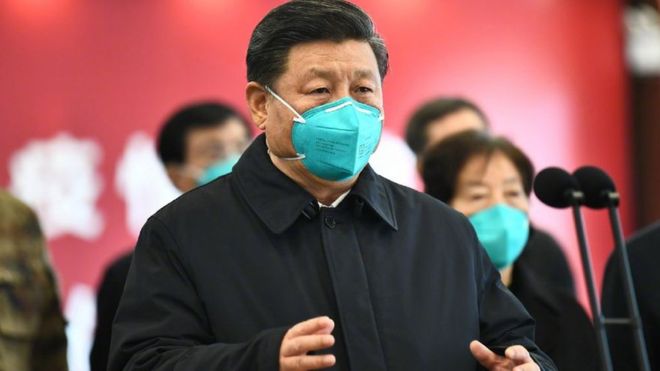
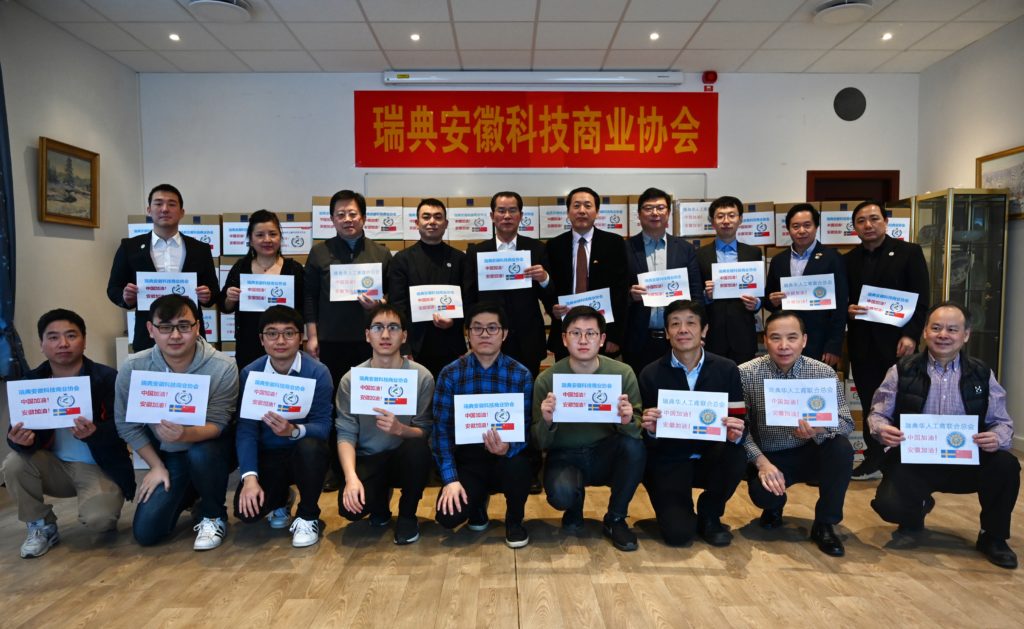
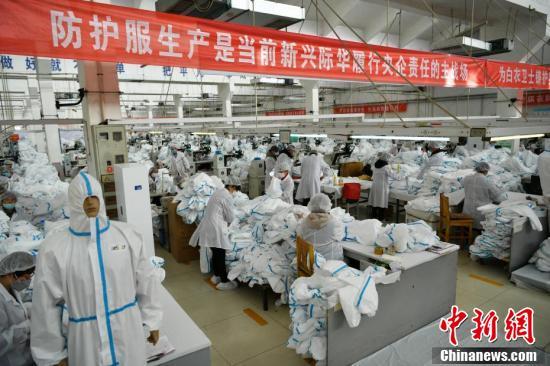
Chinese Ambassador Gui Congyou Appreciates Sweden’s Rational Attitude towards the 2019-nCoV and Kind Support
By Xuefei Chen Axelsson
STOCKHOLM, Feb. 7(Greenpost) — Chinese Ambassador Gui Congyou published a signed article today calling for unity in front of the 2019-nCoV. He also expressed his appreciation for Sweden’s rational attitude towards the nCoV and kind support to China.
He said the 2019-nCoV has aroused wide attention. In front of this situation, the key method to fight against the virus is to avoid being panic, be united and transparent, take right preventive action and deal with it with science and ration. These are just the measures taken in China.
“Chinese government has put the people’s health and life in the first, mobilised the whole country’s resources to form an all dimensional and multi-layer prevention system, which is even stricter than the suggestions required by the World Health Organisation. ” said Gui.
Since the outbreak of the virus, a total of nearly 10 thousand doctors and nurses have been sent to Hubei to support the doctors and nurses there. Within ten more days, China built two professional hospitals specialised to deal with nCoV with the experiences of dealing with SARS in 2003. One hospital can hold 1000 beds and the other holds 1500 beds. So far 1500 patients have been cured and left the hospitals.
Gui said Chinese central government has been open and transparent in sending out the message of virus situation and strengthened international cooperation by reporting to the World Health Organisation and other world science and technology organisations. China’s action has won the appreciation of WHO’s chef Tedros Adhanom Ghebreyesus. He said on Monday there was no need for measures that “unnecessarily interfere with international travel and trade” in trying to halt the spread of a coronavirus.
About people’s worry about the economic impact on China and the world by the virus, Gui said in the short term, the impact can be seen, but in the mid and long term, Chinese economic volume and development persistence have been much bigger than the time when SARS took place, the impact will be temporary and not change the trend of being stable in the long run. The IMF Chair Woman Kristalina Georgieva has also expressed her confidence towards Chinese economy. The World Bank held that Chinese government has sufficient policy space to deal with the virus.
Ambassador Gui said the break of coronavirus is a public health crisis facing mankind and the international community should unite and cooperate to overcome this difficulty. The best curing method for the virus is to unite.
“We appreciate Sweden’s rational attitude to deal with the virus and appreciate Swedish enterprises, society and people’s support to China’s anti coronavirus campaign. Many Swedish friends cheer for Wuhan and China. This was very moving. I believe we can and we shall defeat the virus with the joint efforts of the Chinese government and people and the international community including Sweden. ” said Gui.
According to reports, from the time Wuhan announced to close down, Sweden’s Chinese communities have taken measures to collect donations and buy the masks and other medical protection stuff and sent them to China’s Hubei province where the virus breaking center and neighbouring Zhejiang province.
Swedish enterprises have also taken active measures. Ericsson was one of the companies to help build the two new hospitals in Wuhan, Volvo in Sweden announced large amount of donation.
In the early stage, Swedish DN published an article to say that people should not be panic and eating Chinese food will not help spread the virus if you are not infected.
Many Chinese circles send out the information on how to prevent the virus and inform those who just came back from Wuhan to be isolated at home for two weeks and if there is fever or cough, please call 1177.
A friend in need is a friend indeed.
Chinese Foreign Ministry’s reaction on the US House of Representatives Passing the Uyghur Human Rights Policy Act of 2019
By Xuefei Chen Axelsson
STOCKHOLM, Dec. 9 (Greenpost) — Hua Chunying, Spokesperson of the Chinese Foreign Ministry said recently that the US House of Representatives just passed the Uyghur Human Rights Policy Act of 2019. This bill deliberately smears the human rights condition in Xinjiang, slanders China’s efforts in de-radicalization and counter-terrorism and viciously attacks the Chinese government’s Xinjiang policy.
” It seriously violates international law and basic norms governing international relations, and grossly interferes in China’s internal affairs. China is strongly indignant at and firmly opposed to it.” said Hua.
She continues to say that Xinjiang-related issues are not about human rights, ethnicity or religion, but about fighting violence, terrorism and separatism.Previously, Xinjiang suffered gravely from extremism, violence and terrorism. Faced with severe circumstances, the government of Xinjiang Autonomous Region lawfully fought violent and terrorist crimes while addressing the root causes. Our efforts include advancing de-radicalization, economic growth, ethnic solidarity, social harmony and stability. Thanks to those efforts, Xinjiang hasn’t seen a single terrorist attack over the past three years. Those endeavors are endorsed by all 25 million people of various ethnic groups in Xinjiang. They are also China’s contribution to the global counter-terrorism cause.
She also said the international community speaks highly of China’s Xinjiang policy. Since the end of 2018, over 1,000 representatives have visited Xinjiang in more than 70 groups, including officials from various countries, regions and international organizations, and people from the press, religious groups and the academic circle. They acclaimed that Xinjiang’s experience in counter-terrorism and de-radicalization was worth learning from. In March this year, the Council of Foreign Ministers of the Organization of Islamic Cooperation adopted a resolution which commended China’s efforts in providing care to Muslim citizens. In July, ambassadors of over 50 countries to the UN Office at Geneva co-signed a letter to the president of the UN Human Rights Council and the High Commissioner for Human Rights, applauding China’s respect and protection of human rights in its counter-terrorism and de-radicalization efforts. In October, at the Third Committee session of the 74th UNGA, more than 60 countries commended in their statements the tremendous human rights progress achieved in Xinjiang, China. All those are strong proof that the US accusations on Xinjiang-related issues are entirely against facts and the mainstream public opinion of the international community.
“We state our position clearly to the US that as Xinjiang is part of China, its affairs are purely domestic affairs that allow no foreign interference. This US bill smears our efforts in counter-terrorism and de-radicalization, which only reveals America’s double standards on counter-terrorism and further exposes to the Chinese people its hypocrisy and malicious intentions.” said Hua.
“The Chinese government and people are determined in safeguarding national sovereignty, security and development interests. Under the pretext of Xinjiang-related issues, the US attempts to sow discord among various ethnic groups in China, undermine prosperity and stability in Xinjiang, and contain China’s growth. But its attempt will never succeed. We urge the US to correct its mistakes at once, prevent this bill from becoming law, and stop using Xinjiang-related issues to interfere China’s internal affairs. China will take further reactions according to how the situation develops.” said Hua.
High-level BRIX Seminar : The New Africa Emerges along the Belt & Road
STOCKHOLM, December 8(Greenpost)–Top diplomats from the African Union joined the Chinese Ambassador to Sweden and the Belt and Road Institute’s (BRIX) members in a special seminar on December 5 in Stockholm to outline the great progress being achieved in realizing Africa’s development goals in the context of the Belt and Road Initiative (BRI).
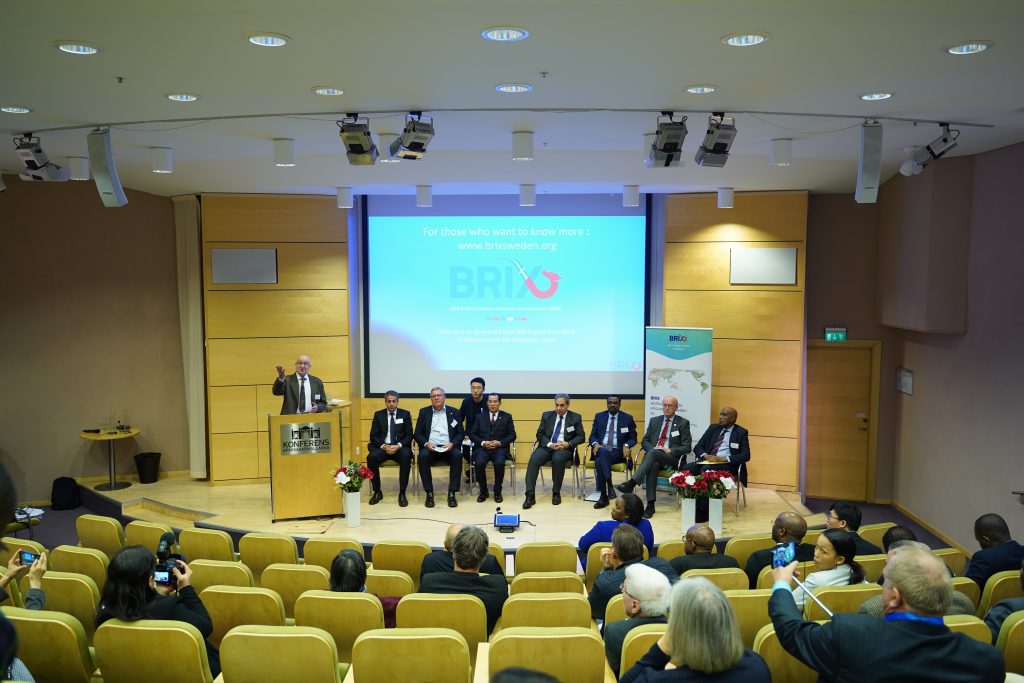
Moreover, the seminar’s more important aspect was to explore the massive potential imbedded in making Africa the greatest economic powerhouse on the planet in the coming decades and how Sweden, Europe and China can cooperate with the African nations to accelerate and benefit from this promising perspective.
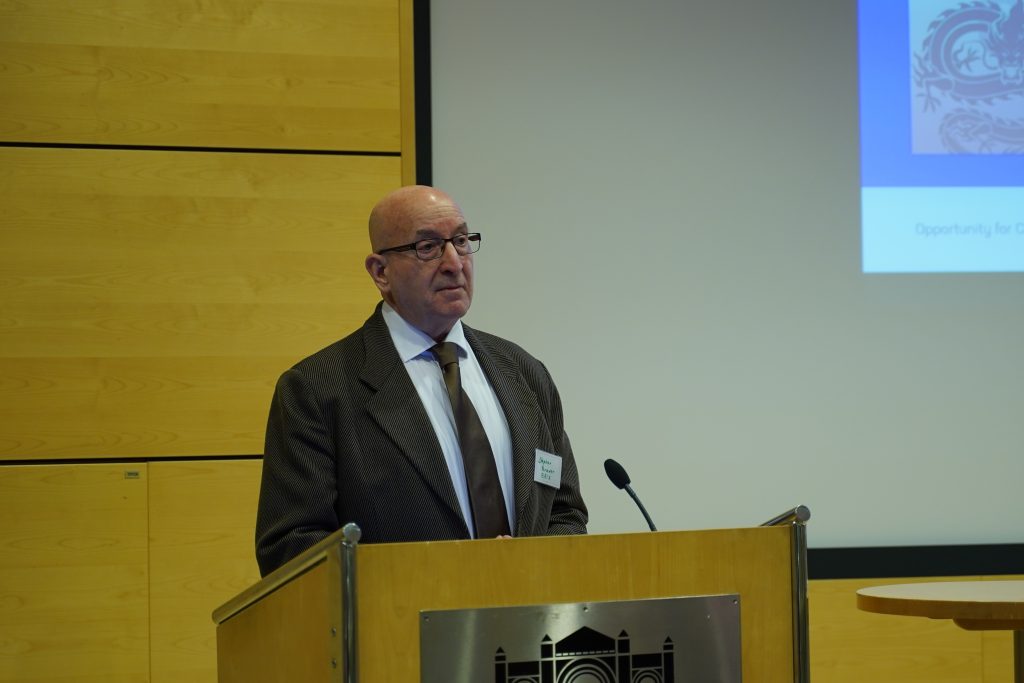
The seminar was initiated by Stephen Brawer, Vice-President of BRIX and moderator of the event. He welcomed everyone and gave a brief history of how BRIX came into being, and about its two other very successful seminars in 2019. The BRIX, which is only one year old, emerged out of a high-level seminar on the strategic and economic impact of the BRI held in May 2018 and organized jointly by the Schiller Institute and the China-Sweden Business Council (CSBC). He emphasized that BRIX works to disseminate knowledge of BRI as a global development process, and to present facts and knowledge based on deeper reflections, and not on superficial opinion based on prejudice and geopolitical agendas. Thus, BRIX believes that in the future, disinformation and propaganda that are spread in Sweden against BRI should be addressed in a more clear and assertive way.
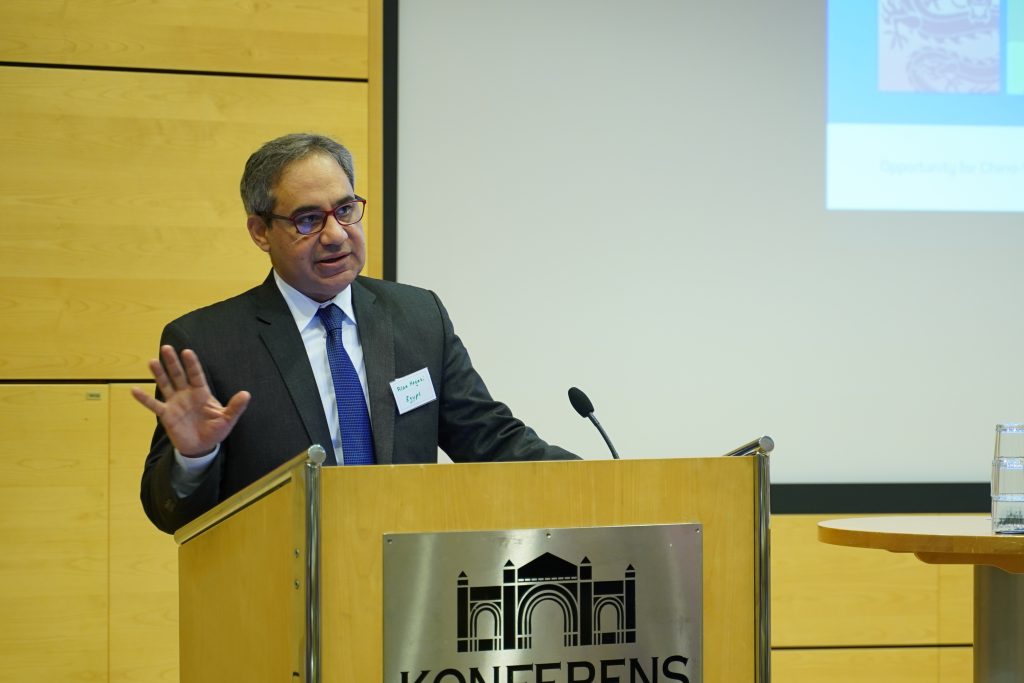
Egypt’s ambassador, Mr. Alaa Hegazy, gave the welcoming speech as representative of the African Union (AU), since Egypt is the current Chairman of the AU. He emphasized the importance of the Belt & Road Initiative for the implementation of Africa’s development plans that have been around for a long time and lacked only the construction starts. He presented the AU’s Agenda 2063 plan for a continental rail and road network, electrification and industrialization. Ambassador Hegazy explained that the AU has several cooperation mechanisms with the EU, UN, Japan, etc., but cooperation with the BRI has been the most dynamic and effective of these mechanisms.
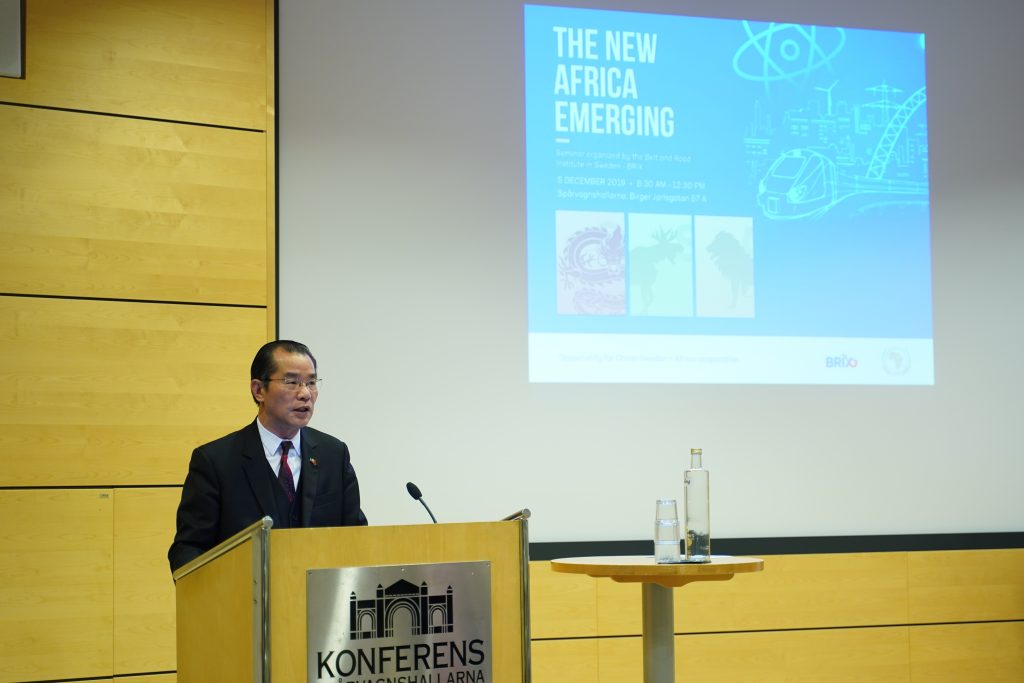
The ambassador of the People’s Republic of China to Sweden, Mr. Gui Congyou gave, the keynote speech of the seminar in which he gave a detailed picture of the extensive cooperation that has been established between China and Africa in the context of the BRI. Ambassador Gui referenced the September 2018 Summit of the Forum on China-Africa Cooperation (FOCAC) in Beijing and the results of that summit. He said: “China-Africa joint construction of the “Belt and Road” initiative has accelerated, and 40 African countries and the AU Commission have signed cooperation documents with China on the “Belt and Road” initiative. We have formulated a country plan based on the actual needs of Africa. We will implement a total of more than 880 China-Africa cooperation projects in the next three years.”
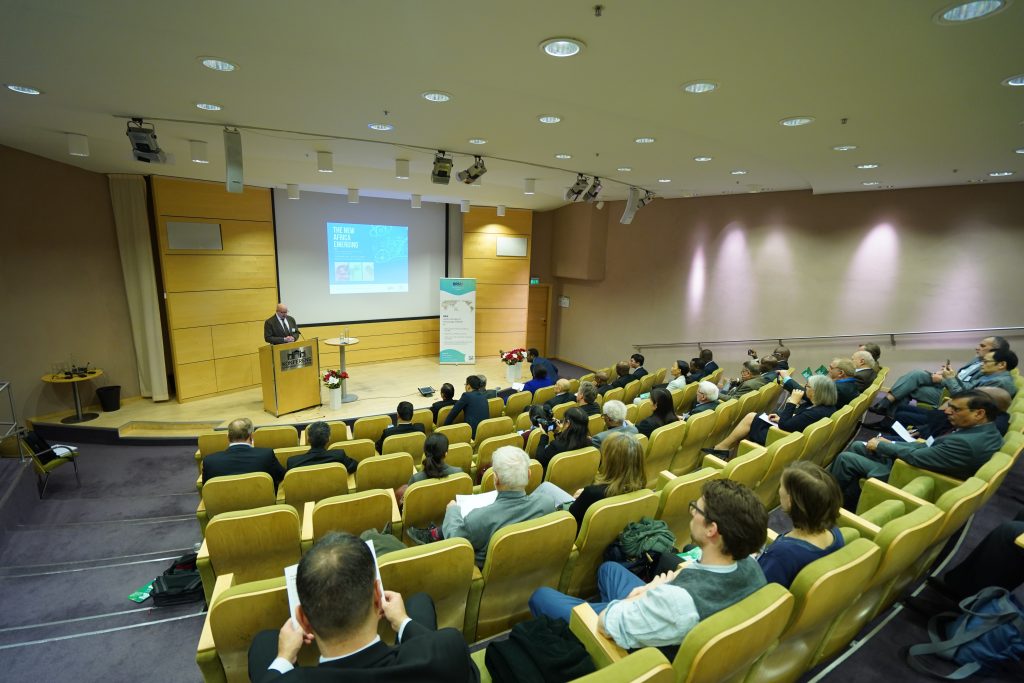
Concerning Chinese-Swedish perspectives, the Ambassador stated: ”The Swedish government has many aid and cooperation projects for Africa, and many large Swedish companies such as Volvo, Scania, and ABB have extensive operations in Africa. China is willing to work with other countries in the world, including Sweden, to complement each other’s strengths and make positive contributions to peace, stability and development in Africa.”
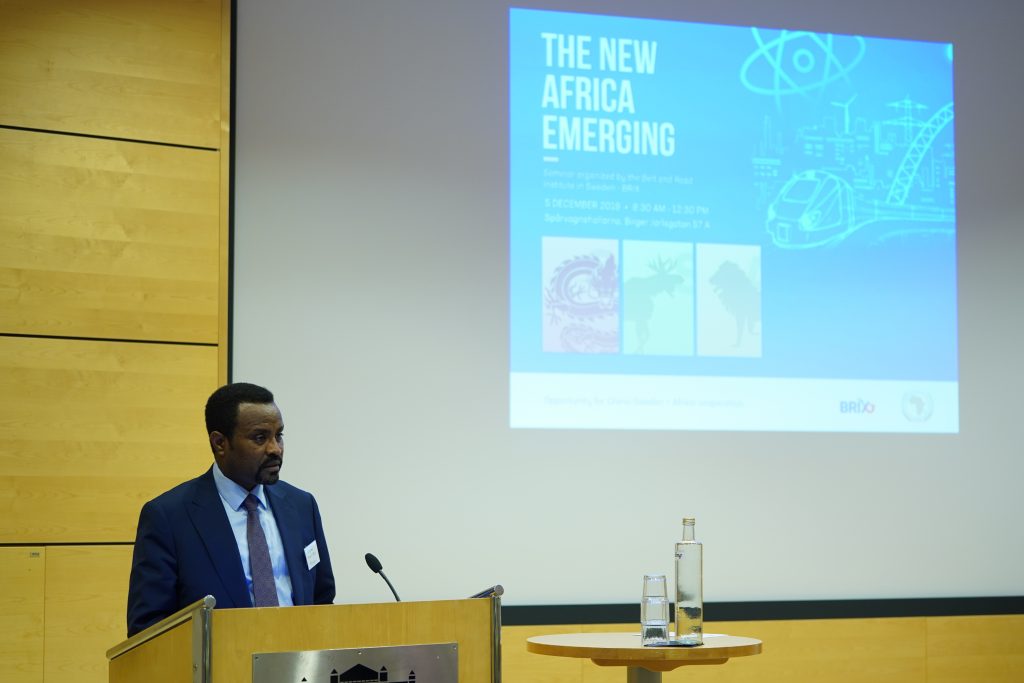
Ethiopia’s Ambassador, Mr. Deriba Kuma showed the audience how Africa’s plans for modernization and industrialization are being implemented. Ethiopia is well on its way to realizing its plans to become a middle-income country by 2025, transitioning from an agricultural-based society to an industry-based one. “Ethiopia is a major beneficiary in the Belt and Road Initiative. Since the country has embarked on expanding its infrastructure network across the nation like roads, railways, telecom and airports; the technical as well as financial support from the Government of China side has helped a lot”, Ambassador Deriba said. He added that “Ethiopia, through its vision of becoming a middle-income country by 2025, has launched an ambitious plan of constructing twelve industrial parks across the nation. Major Chinese companies have participated in the construction of these industrial parks and even some Chinese companies are constructing their own industrial parks in Ethiopia.” He emphasized that “Ethiopia has a plan to have 30 industrial parks by the year 2025. I hereby would like to call up on those competent companies to actively engage in this endeavor either through constructing the industrial parks or by leasing the sheds that could help them to participate in manufacturing of different products.”
Ambassador Kuma also reminded the audience that his country’s Prime Minister, H.E. Dr. Abiy Ahmed, will be receiving the Nobel Peace Price next week. This is an appropriate recognition of the path Ethiopia has taken towards social, political and economic reform.
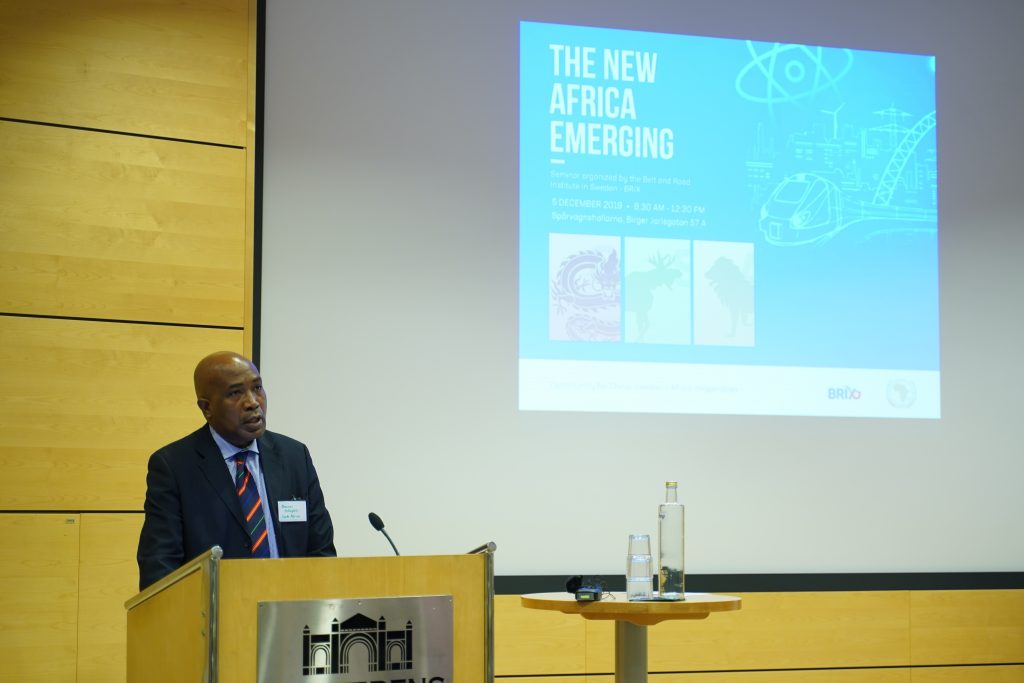
South Africa’s Chargé d’Affaires, Duncan Sebefelo discussed his country’s economic visions and plans, and the challenges and opportunities that exist today. He referenced the major investments China has made in key projects in his country. After the turn of the year, South Africa become the chairman of the AU, outlining the philosophical principles that the AU has for the economic cooperation projects. Mr. Sebefelo explained how important the BRI is for the development goals of the African continent.
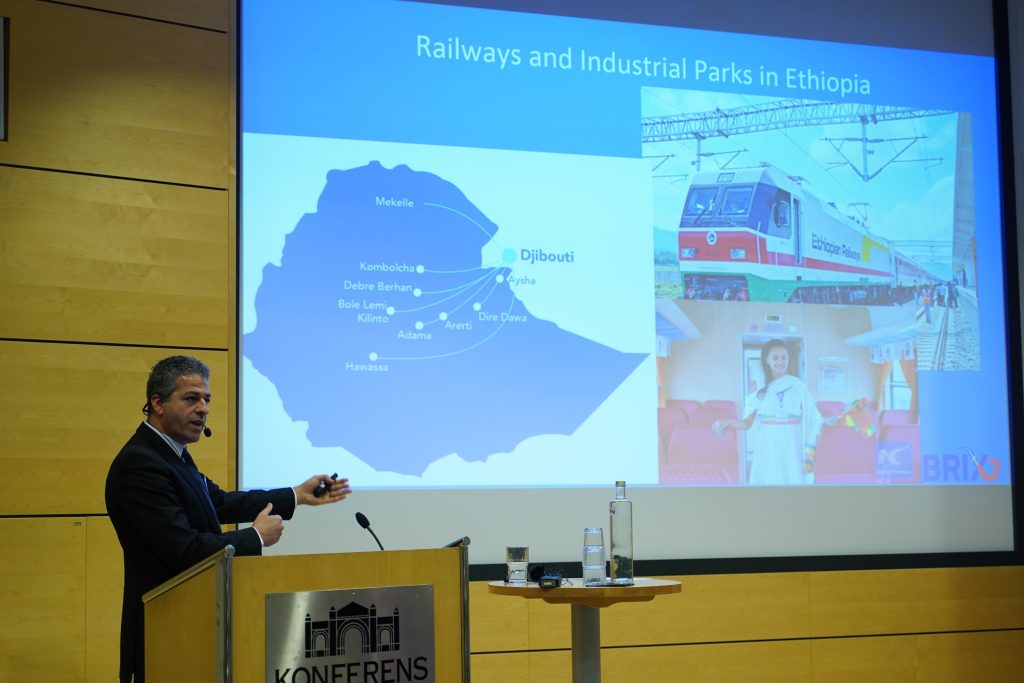
The board member of BRIX, Hussein Askary, made a thorough presentation on “retooling Africa’s rise”. With the help of charts, pictures and maps, he showed how BRI is helping in realizing Africa’s goals. He emphasized that BRIX does not exist to cheer on China or Africa, who can take care of themselves. BRIX’s goal is that Sweden should be part of this process of cooperation and not miss the train towards economic prosperity and stability in the world. In order to achieve that, Sweden’s and Europe’s attitude towards Africa has to change first. He contrasted this attitude to that of China. While Sweden and the Eu considered Africa “a problem”, China considers Africa “an opportunity”. Askary explained that a major part of this problem is the “aid” mentality. He argued that the Chinese way of “empowering rather than helping”, which is to supply Africa with the “tools” for development such as infrastructure, industrialization and technology transfer is the most suitable for Sweden and Europe to follow. Under the heading “SDG acrobatics” (Sustainable Development Goals), he talked about how Sweden and the EU are redefining the UN development agenda in 2030, so that the most important priority goals to be addressed (poverty, hunger, healthcare, electricity education, water, industrialization, etc.) are placed at the bottom of the priority list, while Climate Action, goal no. 13, is at the top. In conclusion, he explained that with the help of China and the BRI, Africa is well on the way to realizing its Agenda 2063. But he asked how faster can this agenda be realized if Sweden and the EU contribute to it?
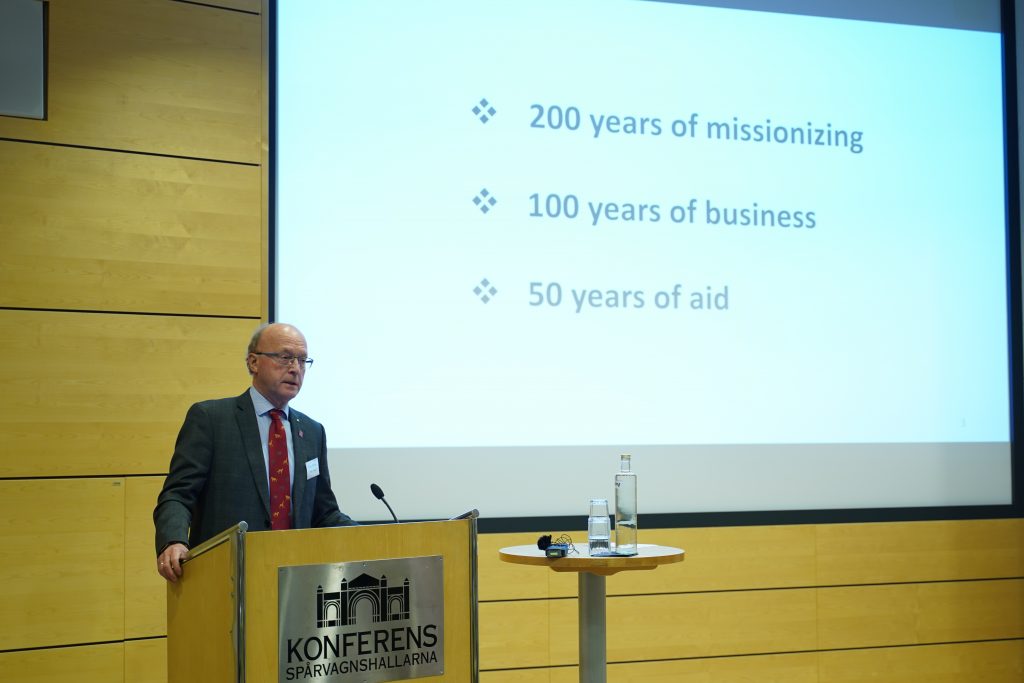
The Norwegian former member of parliamentary, and co-founder of Ichi Foundation, Mr. Thore Vestby, talked about the Norwegian cooperation with Africa, which has been largely restricted to aid through NORAD. But a new focus on cooperation has been established in 2012 through the Norwegian African Business Association by leading Norwegian companies (norwegianafrican.no). Norway also needs to establish cooperation with BRI, Vestby emphasized, and a shift in the attitude in Norway towards China and the BRI is necessary. He congratulated the Swedish BRIX for its successful work and announced that a “BRIX Norway” will be started in the new year.
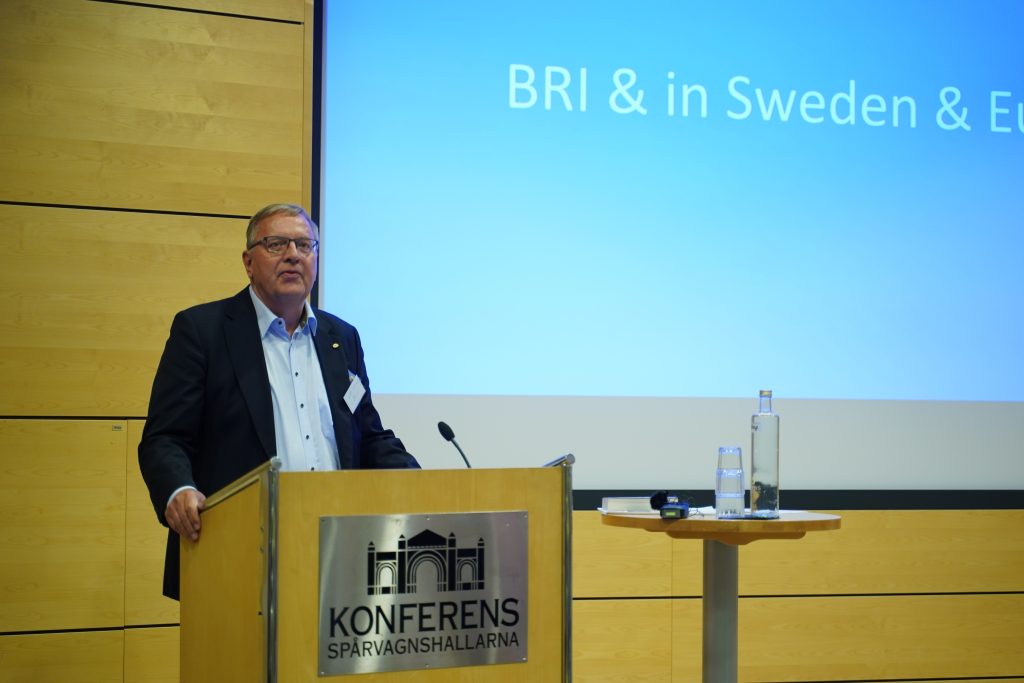
BRIX member and private consultant, Mr. Lars Aspling, explained in his presentation that now 16 of 28 EU countries have already signed agreements (MOU) with China to cooperate with the BRI. This shows that such an agreement, or even a mere positive opinion on BRI, as France and Finland have expressed, need not necessarily to divide the EU. Although the Swedish government, with its proposal for a new China strategy, adheres to EU policy, there are, thus, no legal issues that hinder Sweden from joining the BRI. But only a lack of political will stands in the way, he stated. Aspling gave a tour of the necessary investments that need to be made in northern Europe, Scandinavia and Sweden to be able to rise to the levels of productivity necessary in the new BRI era.
Aspling seized the opportunity to announce that a new report that BRIX has just published about what BRI on the importance of Sweden’s cooperation with the BRI can now be downloaded from the BRIX website. (Https://www.brixsweden.org/brix-publicerar-en-ny-belt-and-road-speciell-rapport/).
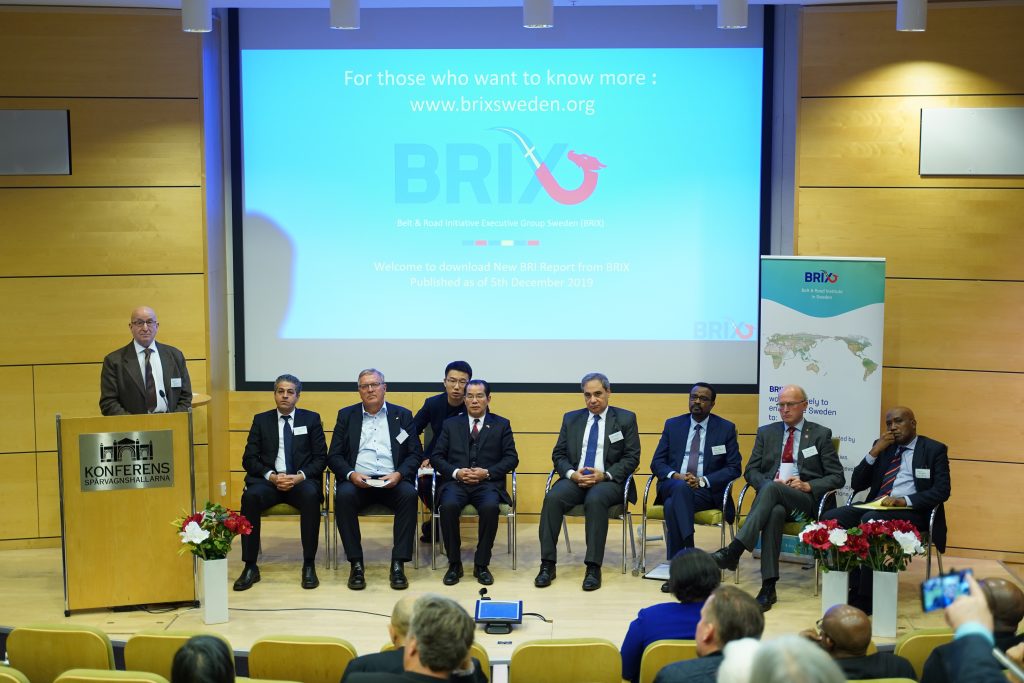
The seminar’s moderator, Stephen Brawer, led the closing panel debate where the speakers answered questions fielded by the audience.
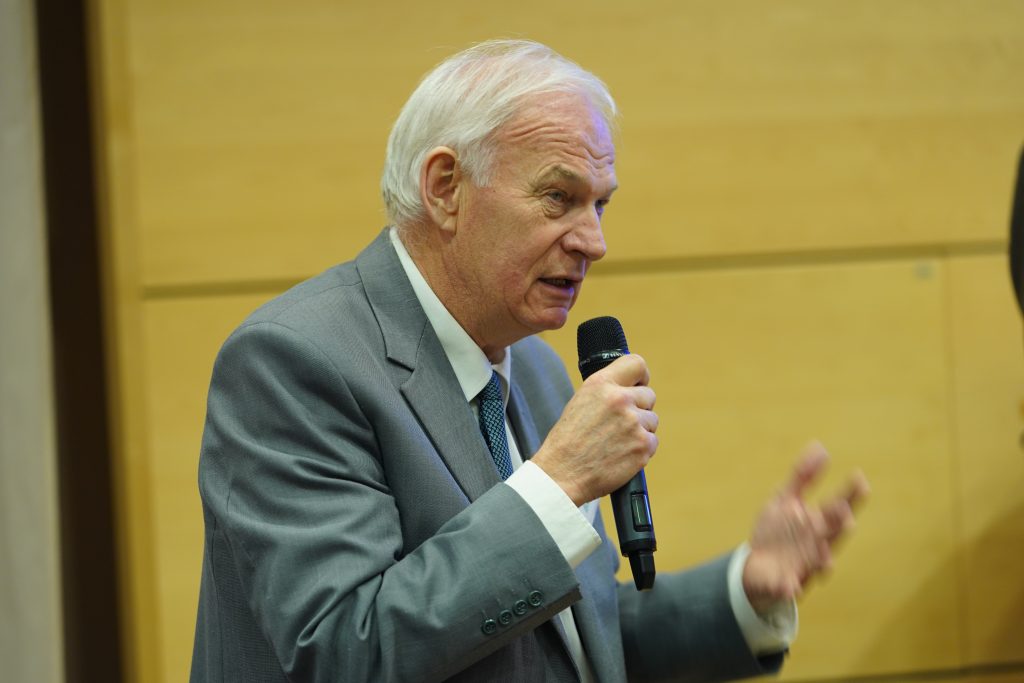
BRIX chairman Ulf Sandmark commented on the question and discussion about corruption in Africa by pointing out that BRI has a focus on real investments that are not handed over as sums of money like the investments made by the West. The BRI investments are delivered as cement, steel, machinery and input products for the projects. “Cement is difficult to put into a bank account, which means that BRI has an intrinsic mechanism to prevent corruption,” he said.
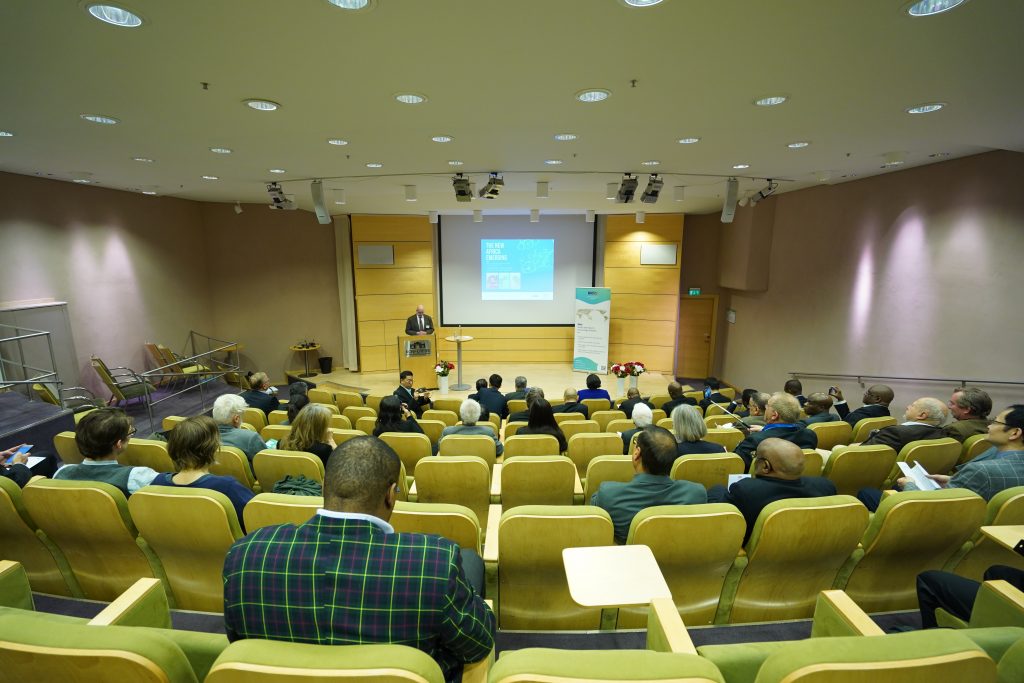
In closing the seminar, moderator Stephen Brawer again emphasized the need to present fact-based information and knowledge about BRI, and made a point of thanking the effort that TV100 and Fredrik Vargas make through their important work in reporting the proceedings of this seminar.
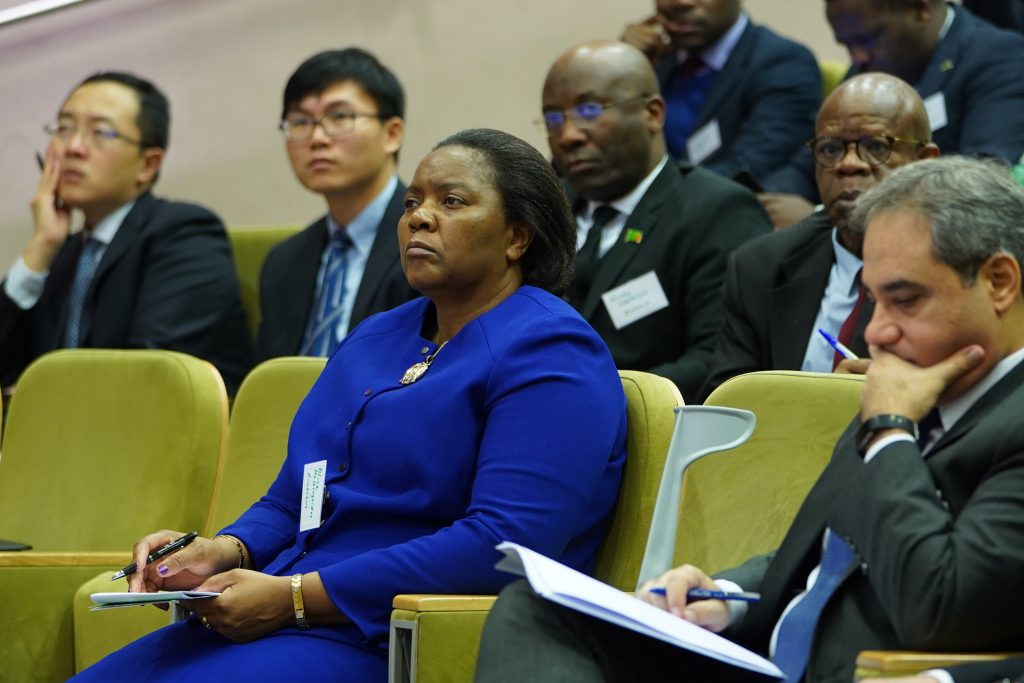
19 diplomats from 15 countries (mostly from Africa) participated in the seminar which was attended by 60 guests.
Hunan Cultural and Tourism Promotion Conference held in Stockholm
By Xuefei Chen Axelsson
STOCKHOLM, Nov. 29(Greenpost) — Hunan Cultural and Tourism Promotion conference was successfully held at Sheraton Hotel in Stockholm on Friday.
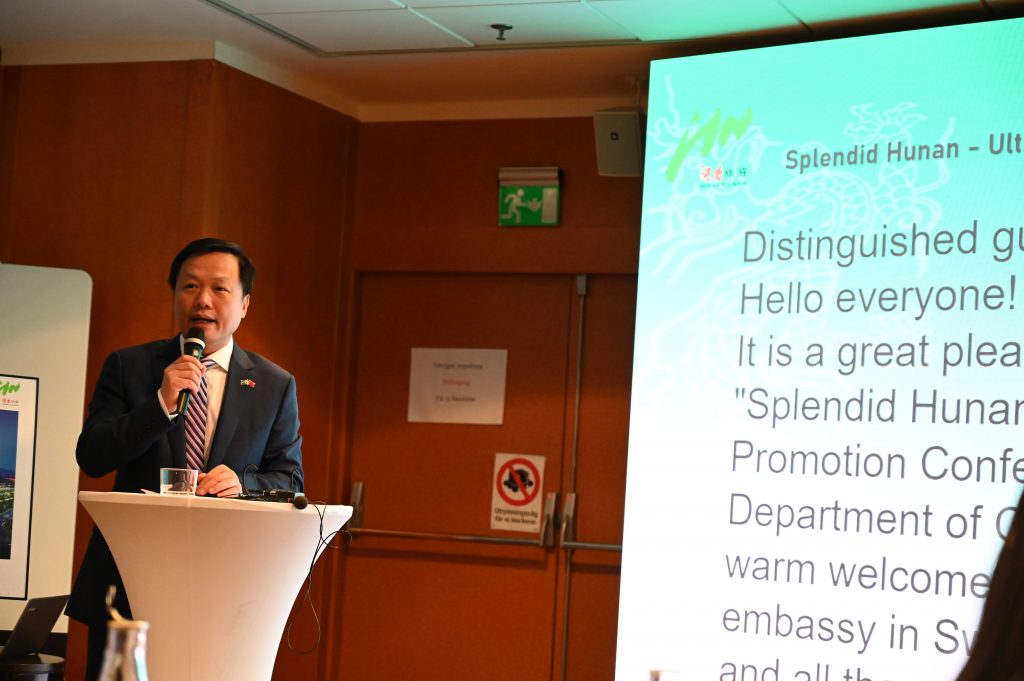
Yu Xinrong, Secretary of Party Committee of Department of Culture and Tourism of Hunan Province, Central China said Hunan enjoys very rich tourism resources and has many cultural relics such as Yueyanglou Pagoda, Mawangdui cemetery, Maozedong’s hometown. The famous Zhangjiajie tourism spot was the shooting site for animation Avanda, its beauty has attracted many people.
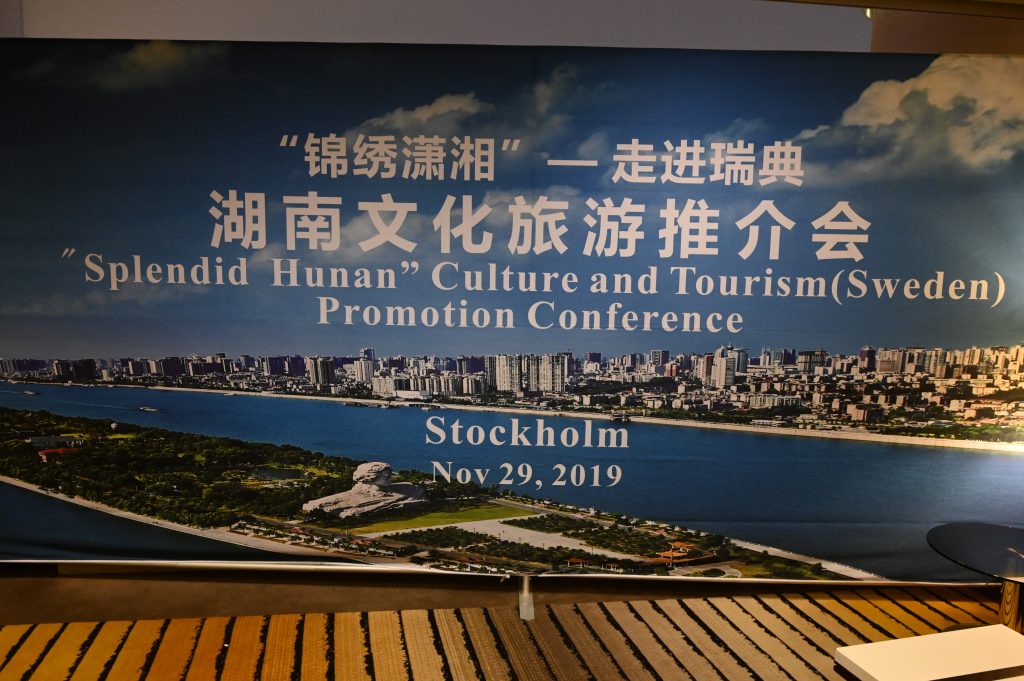
Yu said that Hunan also has China’s largest lake Dongting Lake which stretches over 400 kilometers. Hunan has many ethnic minorities thus has rich culture. Hunan’s cuisine is famous for its hotness. The pheonix city and Furong Town are famous for its history.
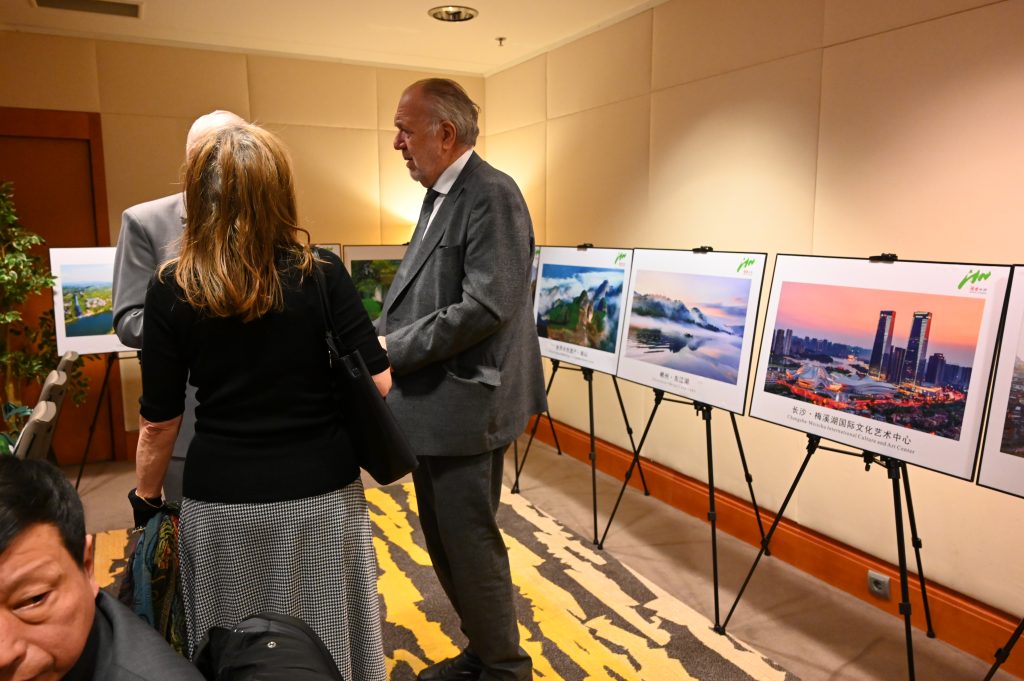
The ancestors of the Chinese nation, Emperor Yan and Emperor Shun were buried in Hunan, Zeng Guofan and Zuo Zongtang were born in Hunan and became famous for their achievements in Chinese history. Hunan also boasts many ethnic groups which all have their own culture and traditions.
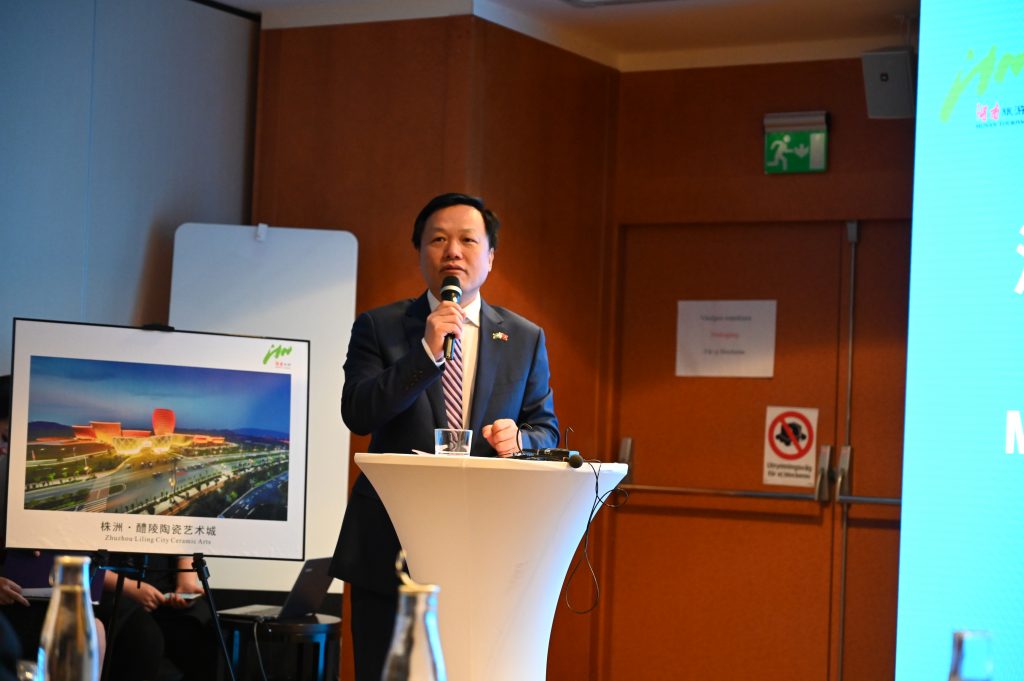
Yu Xinrong welcomed Swedish friends to visit Hunan and enjoyed the diversity in Hunan.
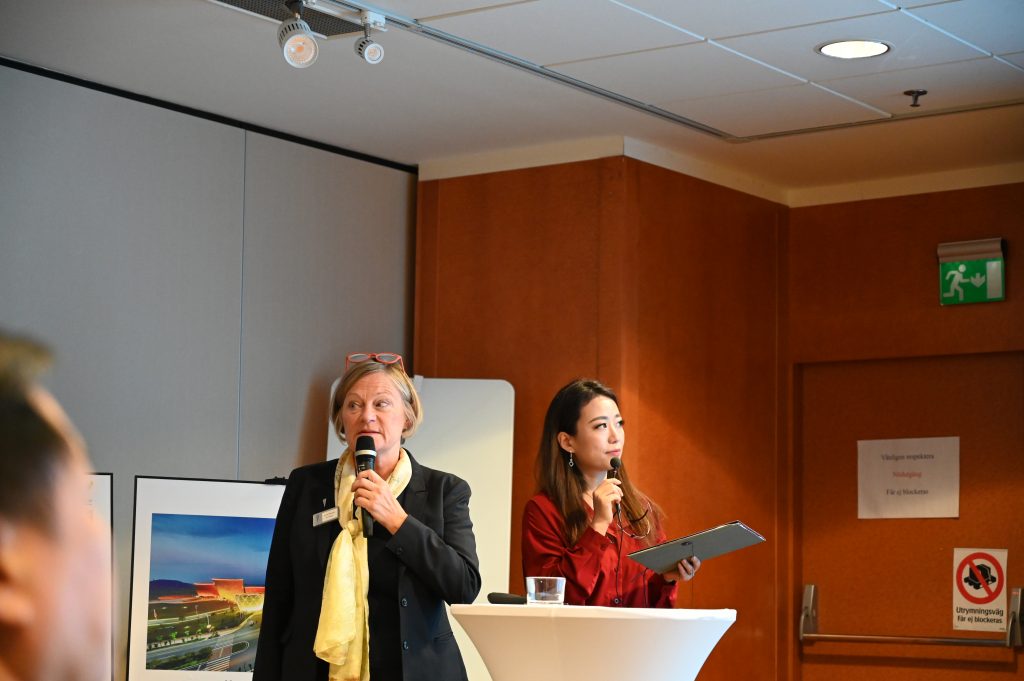
Cecilia Rahmqvist, Director of Laplands tourism bureau in northern Sweden also introduced Kiruna’s Ice Hotel, Tree Hotel and Ice tourism resources. She said that they used solar energy to keep the ice even in summer. She welcomed Chinese tourists to visit them.
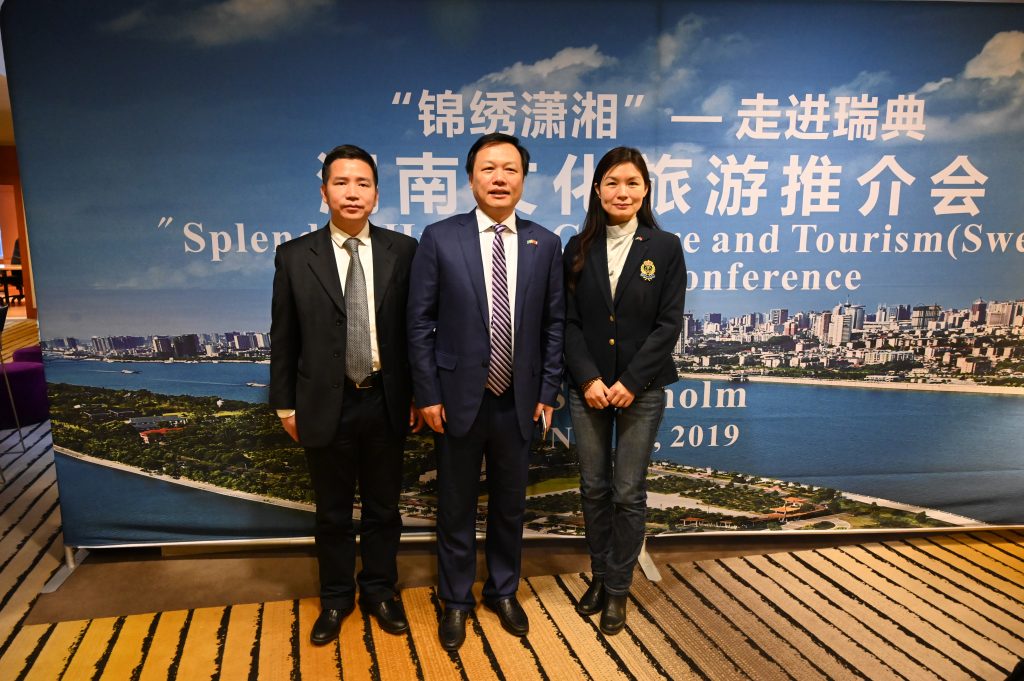
Liu Fang, President of Hunan and Hubei Town-fellow Association in Sweden expressed her welcome to the Hunan delegation. She said her association has been promoting Hunan and Hubei culture in Sweden by holding Duanwu festival every year.
During the promotion conference, audience also watched promotion video which showed all the beautiful tourism resources and infrastructure in Hunan and impressed the audience a lot.
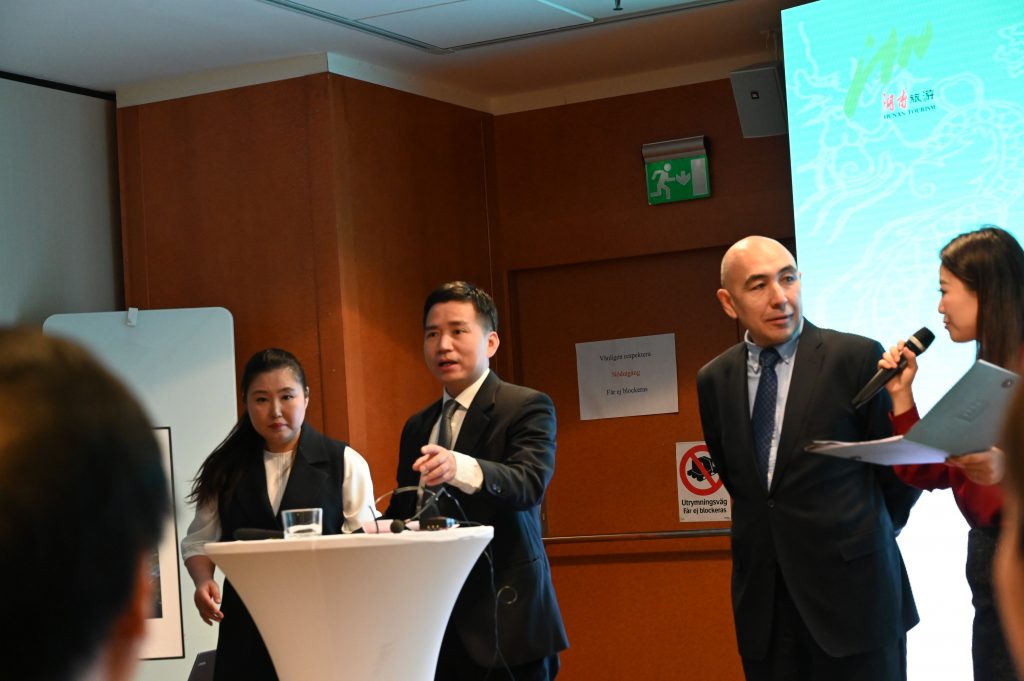
Cao Diefeng, Counselor of Education department of Chinese Embassy in Sweden also attended the conference.
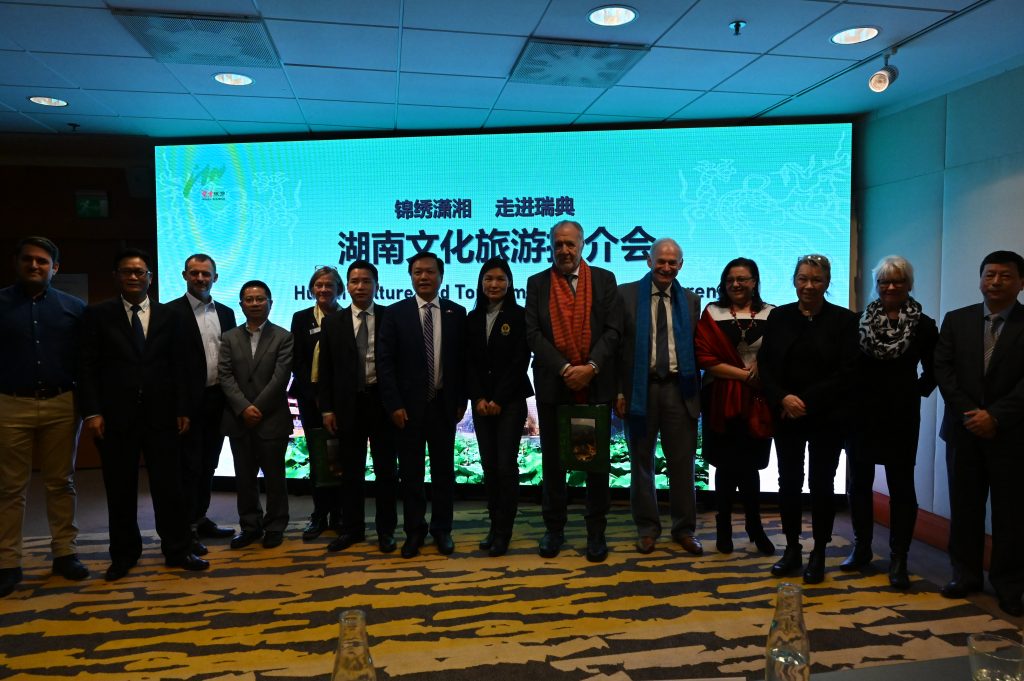
Other guests include Zhu Jinchuan, General Manager of Air China in Stockholm, Zhang Shouting, President of Nordic China Sustainable Development Association and Ulf from BRIX.
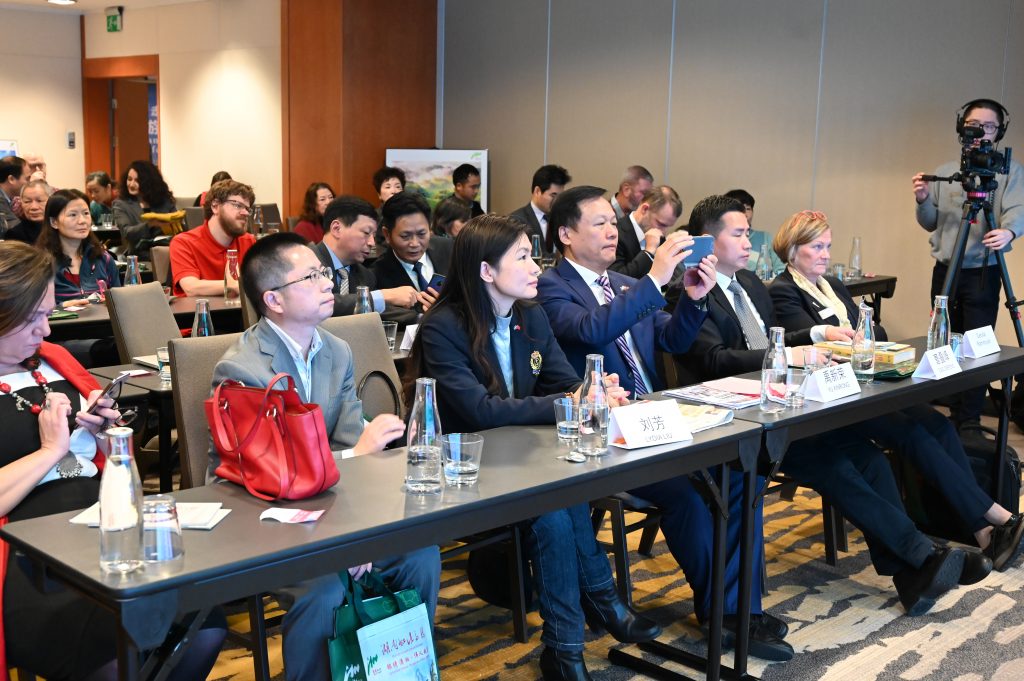
During the promotion conference, a dozen of pictures showing the beauty of Hunan were also displayed.
Photo and Text by Xuefei Chen Axelsson
2019年9月末中国外汇储备规模增至30924亿美元
北欧绿色邮报网援引中新社报道:据国家外汇管理局网站消息,国家外汇管理局新闻发言人、总经济师王春英透露,截至2019年9月末,中国外汇储备规模为30924亿美元,较年初上升197亿美元,升幅0.6%。
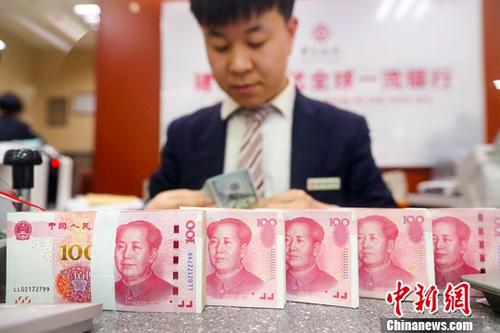
山西省太原市一银行工作人员清点货币。(资料图片)中新社记者 张云 摄
国家外汇管理局新闻发言人、总经济师王春英就2019年9月份外汇储备规模变动情况答记者问。有记者提问:国家外汇管理局刚刚公布了最新外汇储备规模数据。请问造成2019年9月外汇储备规模变动的原因是什么?今后的外汇储备规模趋势是怎样的?
王春英回应,截至2019年9月末,中国外汇储备规模为30924亿美元,较年初上升197亿美元,升幅0.6%。
王春英表示,9月,中国外汇市场供求保持基本平衡。受全球经济增长、主要国家央行货币政策、全球贸易局势、地缘政治因素等影响,美元指数上涨,主要国家债券价格下跌。汇率折算和资产价格变化等因素综合影响外汇储备规模。
王春英称,今年以来,在国际形势错综复杂的背景下,中国经济运行总体平稳、稳中有进,主要经济指标处于合理区间,经济结构持续优化,高质量发展积极因素增多。受此支撑,中国外汇市场运行平稳,外汇储备规模小幅波动主要受估值因素影响,规模总体保持稳定。
此外,王春英提到,往前看,国际经济金融环境不稳定不确定因素增多,全球经济增长放缓,贸易保护主义和单边主义上升,国际金融市场波动性加大。但中国经济发展有巨大的韧性、潜力和回旋余地,长期向好的发展态势没有改变,并继续推进全方位改革开放,这将为外汇储备规模保持总体稳定提供有力支撑。(责任编辑查正富 主编陈雪霏)
Shenzhen Promotion and Communication Presentation held in Stockholm
By Xuefei Chen Axelsson
STOCKHOLM, Sept. 24 (Greenpost) — Shenzhen Promotion and Communication Presentation was held in Stockholm on Tuesday.
Zhang Qiaozhen, President of the General Chamber of Commerce, Cao Diefeng, Counsular of Education at the Chinese Embassy, Fan Kun, Vice President of Shenzhen Overseas Communication Association and dozens of masters or Phd students from universities in Stockholm attended the presentation.
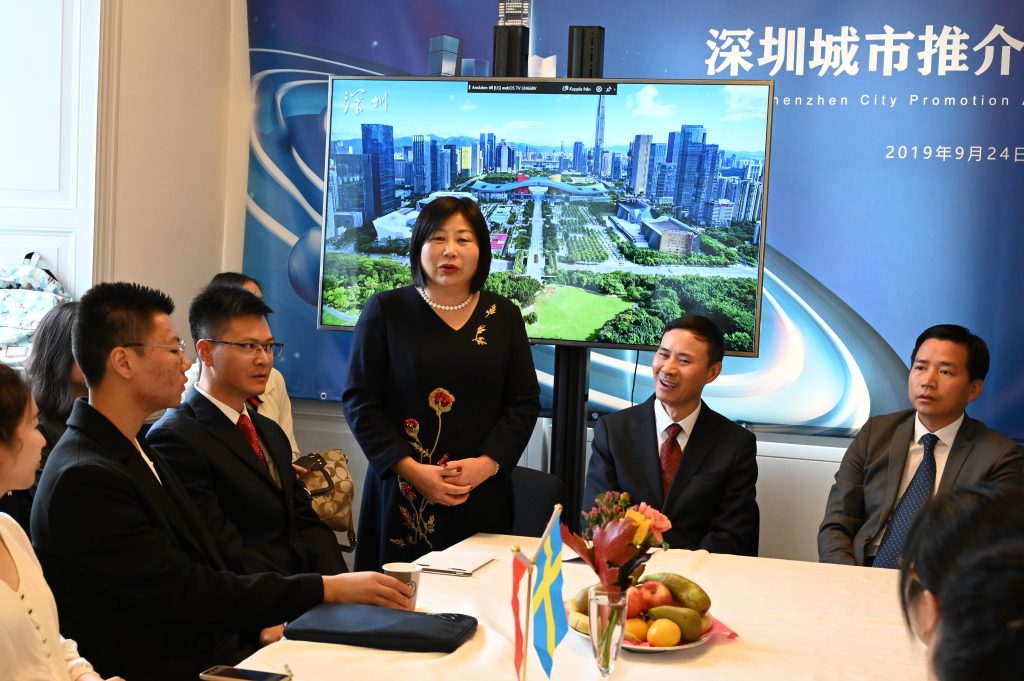
President Zhang congratulated the presentation. She explained that the goal of her Nordic-Shenzhen General Chamber of Commerce is to promote the communication between Shenzhen and Nordic countries. We have helped nordic enterprises to go to Shenzhen and Guangzhou to attend trade and high tech fairs as well as cultural exhibitions。Today we have Shenzhen delegation coming to Sweden to present Shenzhen to you. Let’s welcome Fan Kun, Vice President of Shenzhen Overseas Communication Association.
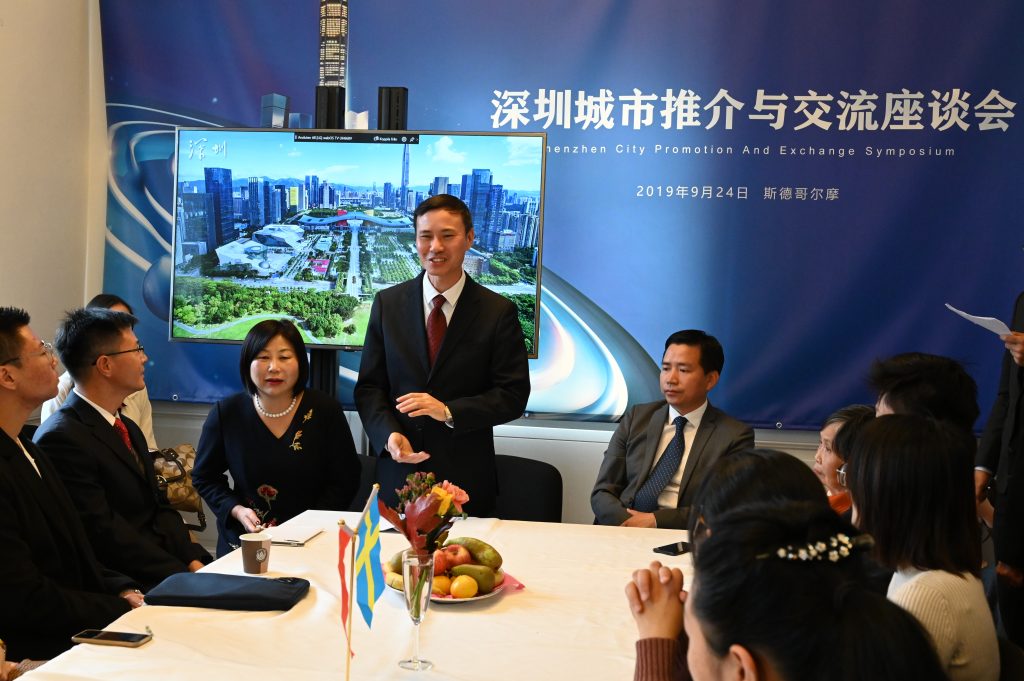
Fan Kun said Shenzhen used to be a small fishing village with a population of only 30 thousand. Now it is one of the most innovative cities all over China.
Shenzhen aims to become a roll model for Chinese cities by 2030 and 2049 and it can even be the world’s model city. Shenzhen has wonderful environment with the lowest in PM 2.5. The city is very young and vital. It is very good for young talented people to work in Shenzhen. The treatment is very good if you can have good project or achievement, said Fan.
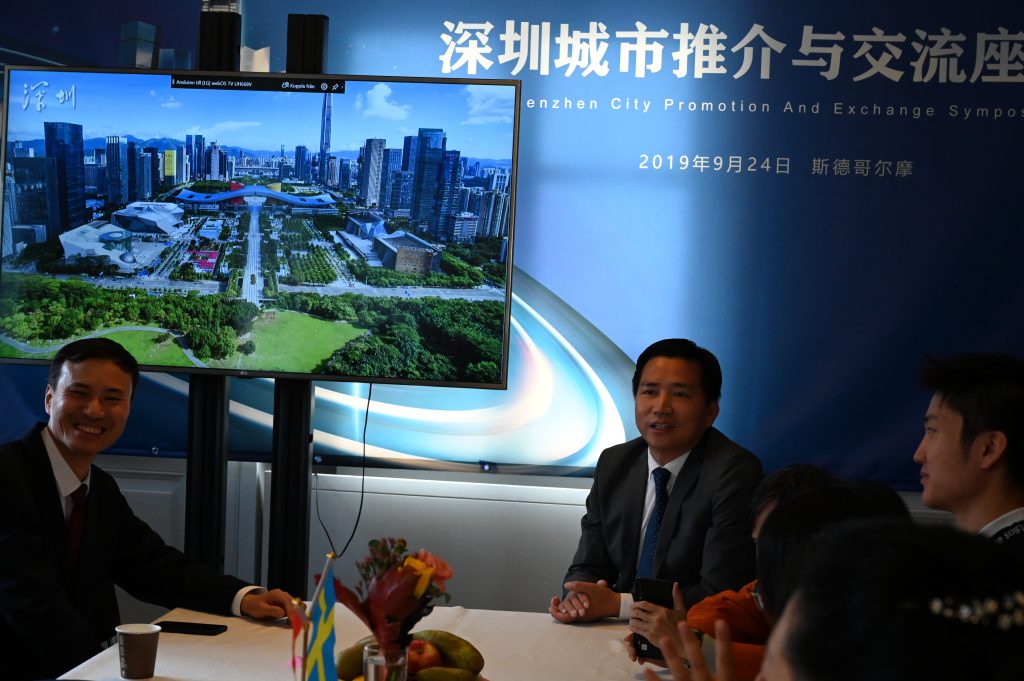
Counsular Cao encouraged the students to go to Shenzhen to work saying that they can have a good communication to take this opportunity.
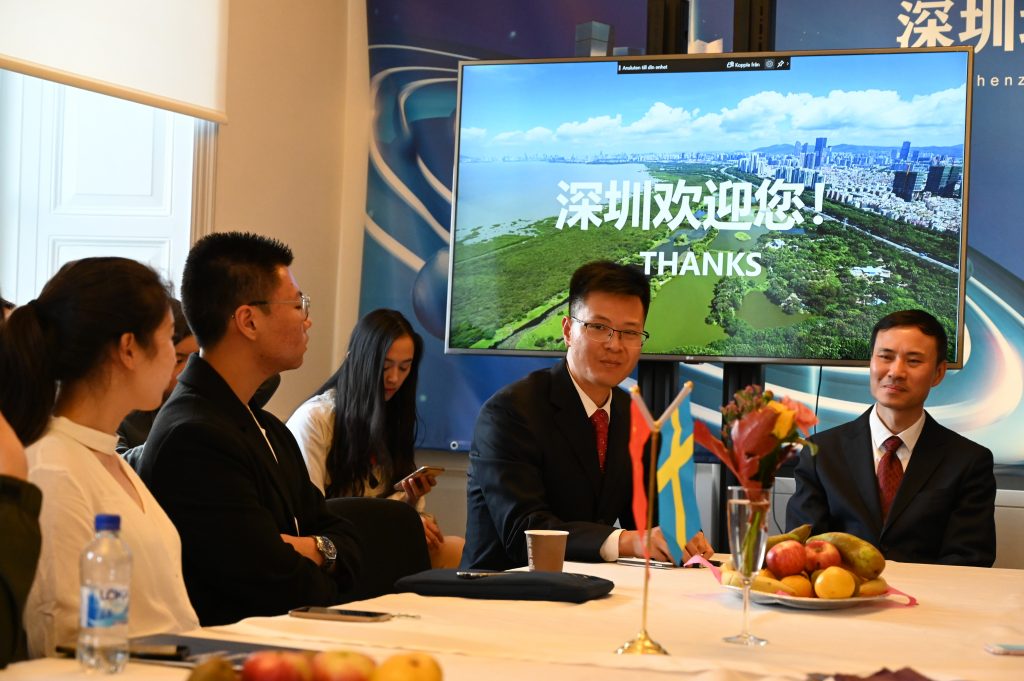
Liu Huadian from Shenzhen Overseas Communication Association said the average age in Shenzhen is just 33 years old. So the city is the youngest one in China. The net increase of population reached by half a million to over 13 million . There are many volunteers in Shenzhen and people from Hong Kong, Macao and Taiwan reached 150 thousand by the end of last year. Shenzhen is very open and all the information about talented people from overseas are published on website.
They also answered questions from the students.
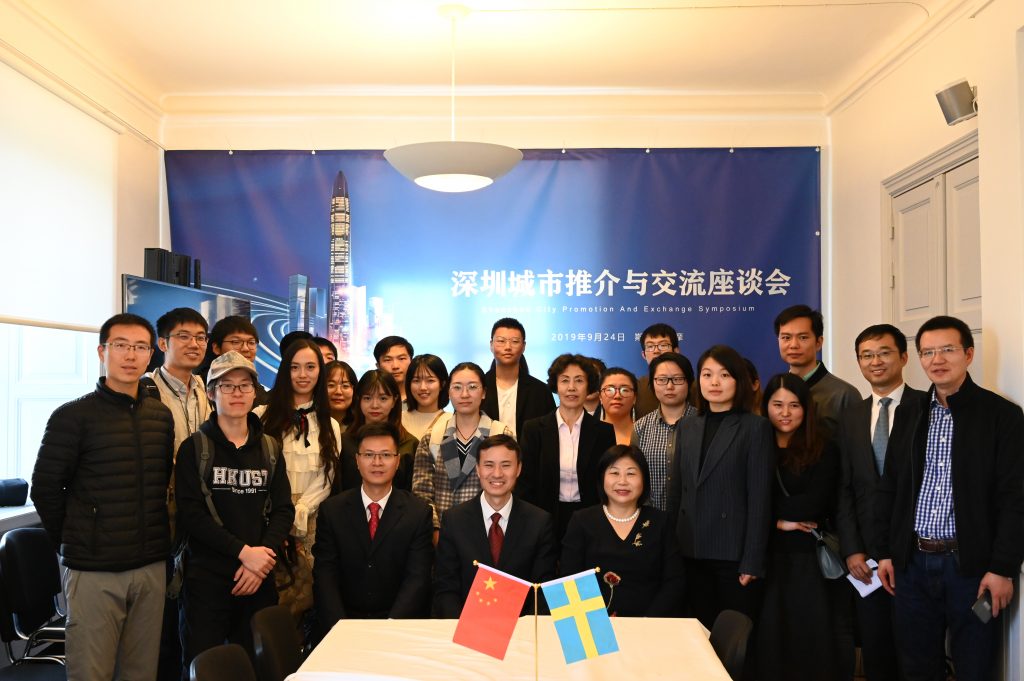
Shenzhen has become an admirable city for talented people. The exchange and promotion seminar was organized by Shenzhen Overseas Communication Association.








